Editor’s note: This research project owes much to three people who deserve acknowledgement: Janice Grace, Long Branch historian, Library Associate and History Room Manager of the Long Branch Free Public Library; Robert Waitt, president, Historical Society of Ocean Grove; and Randall Gabrielan, longtime regional historian and author, most recently of Lost Monmouth County (The History Press, 2021). All of them provided facts and/or images, and more importantly, valuable guidance in finding supporting documentation for this story, and we are so grateful to each of them for their time and effort.
We reached out to other obvious groups and people connected to this story seeking any information. It is hoped we may yet receive a response. Presented with valid evidence, we are happy to revise this text so that it is as accurate as possible.
It is also important to note that many of the conclusions reached herein are based on newspaper reports. The farther back in time one goes, the less newspaper accounts can be trusted. For decades upon decades, newspapers served primarily as entertainment and mixed purely fictional content alongside actual news of the day. Any claims that are based on a single newspaper account – even The New York Times – should be regarded with skepticism. The primary content of early newspapers was often stories published in other newspapers, and so, a claim based on several newspapers having printed the exact same story should likewise be regarded.
By John R. Barrows
On September 4, 1931, Rev. Morton A. Barnes, pastor of the St. James Episcopal Church on Broadway in Long Branch, wrote the following in a letter to the editor of the Asbury Park Press:
Since there is serious doubt in the minds of those who have an intimate knowledge of the history of the chapel at Elberon, as to whether any president has worshipped in the building, it would seem as if the facts ought to be very thoroly [sic] established before the claim is made and especially in sending out appeals for financial aid under a title which might seem to be without foundation.
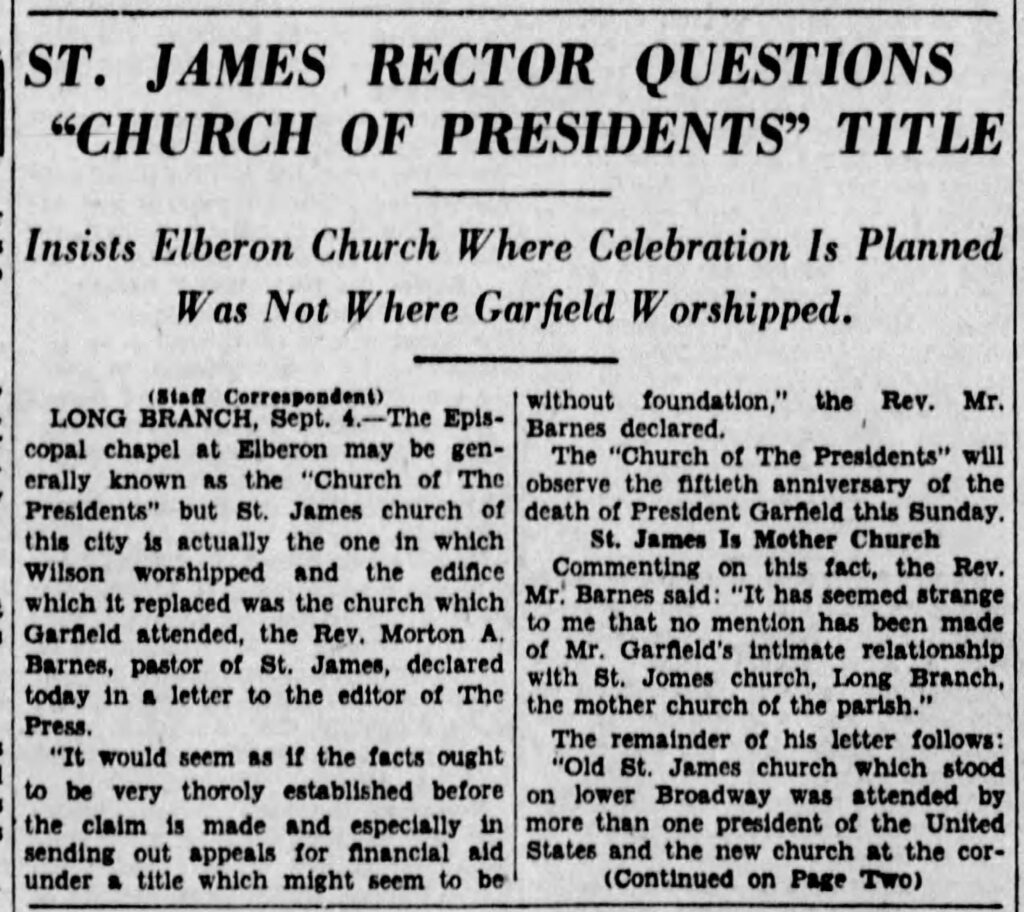
As far as we can determine, no one has chosen to meet Rev. Barnes’ challenge: to thoroughly establish the facts, as best as is possible from the evidence that exists, and evaluate the more prominent claims in Monmouth County over the years relating to presidential visitations. This Timeline is an effort to do just that.

Ulysses S. Grant, 18th president, in office March 4, 1869 – March 4, 1877.
As with many communities, Long Branch civic leaders have taken great pride in their town being chosen by prominent persons for summer visitations over the years. For example:
“In those days, Long Branch could boast of many historical and beautiful things, such as the President Grant House and the homes of Civil-War Gens. Thomas T. Eckert and Winfield Scott.” Edgar N. Dinkelspiel, Long Branch City Councilman, 1989.
On July 19th, 1869, U.S. President Ulysses S. Grant, after just months in office, visited Long Branch with his family for the first time, and found it to his liking.
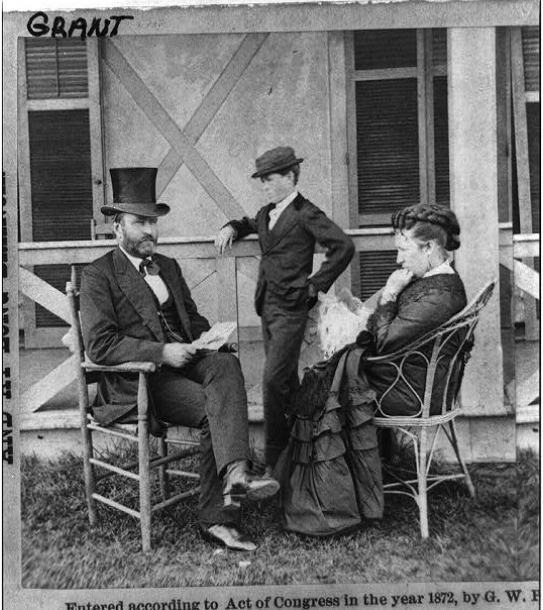
Grant spent all eight summers of his presidency in Long Branch, staying at various locations the first year, and thereafter in a magnificent mansion on the beach somehow called a cottage, built for him by local boosters.
Grant was the first sitting president to visit Long Branch and the first to summer there. His celebrity presence made Long Branch known across the country, and attracted numerous curious new visitors to the region.
On July 10, 1875, Grant participated in ceremonies marking the anniversary of the Ocean Grove Association, the governing body of this unincorporated community within Neptune Township. The Ocean Grove Record reported:
President Grant had been detained, but to the gratification, of all, arrived about 1 p.m., and with his lady; dined at the Pitman House as the guest of President Stokes and members of the Ocean Grove Association. After dinner, Mrs. Grant joined the choir in singing a number of patriotic and religious pieces, and the President was conducted to the Auditorium, where he was presented to the people, and gave a willing and cheerful interval to hand-shaking.
Grant was raised a Methodist in Illinois, and he had expressed that while he at West Point, the academy sought to convert cadets into “gentlemanly Episcopalians,” which he resisted. Grant’s wife Julie was a devout Methodist, and she was said to be disappointed that he was largely disinterested in church-going.
President Grant’s sister was a summer resident on Lake Avenue in Ocean Grove during this time, and the president and First Lady were known to visit her there on several occasions.
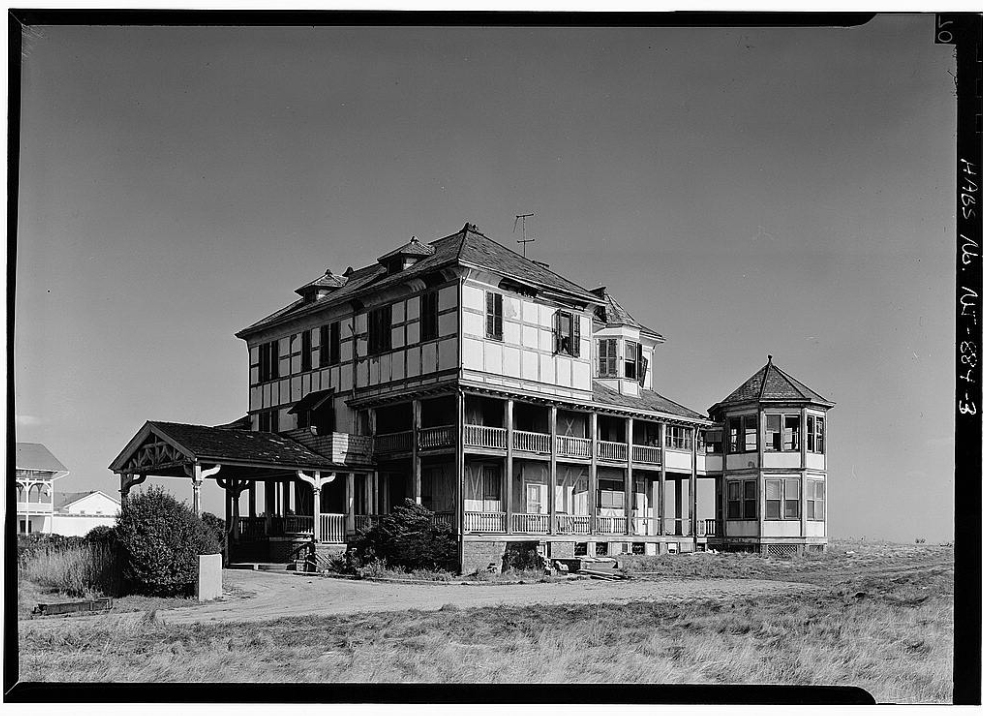
On June 19, 1881, The New York Times reported former president Grant had returned to Long Branch, when President Garfield and his family were already vacationing there:
President Garfield and Mrs. Garfield…attended service in the morning in the Church of St. James, in the village of East Long Branch. Gen. Grant and Mrs. Grant attended the St. James Chapel, near the Elberon Hotel.
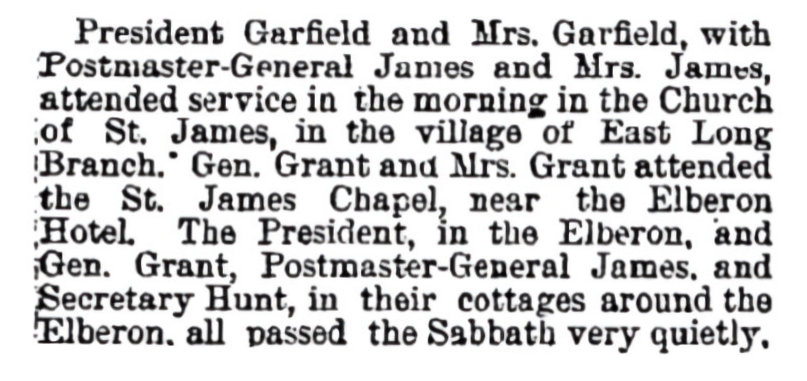
Grant’s last public appearance was in the Great Auditorium at Ocean Grove, on August 4, 1884, at a reunion of the Army chaplains of the Civil War.
Ulysses S. Grant summered in Long Branch all eight years while president; participated in major ceremonies at Ocean Grove while president; and, as former president, attended services at the St. James Chapel. The final claim is attributed to a single story in The New York Times. The question lingers, why would Grant’s attendance be covered by a New York City newspaper, but not any of the four Monmouth County daily newspapers of the time, including the Long Branch Daily Record?
St. James, the Church, versus St. James, the Chapel

The St. James Episcopal Church, established in 1854, was first located on the south side of Broadway between Second Avenue and Memorial Parkway, and flourished there for forty years. The need for a larger facility led to St. James building a new church located at 300 Broadway in Long Branch, which was formally dedicated in April 1913, and officially consecrated in February of 1939. In the late 19th century, an expanding array of oceanfront attractions brought numerous wealthy and famous people to the Long Branch shores, and on the Sabbath, to the Church. President James A. Garfield visited the original church on June 26, 1881, while President Woodrow Wilson attended services on October 9, 1916, in the new facility. Bronze tablets marked the pews where they sat during these services.
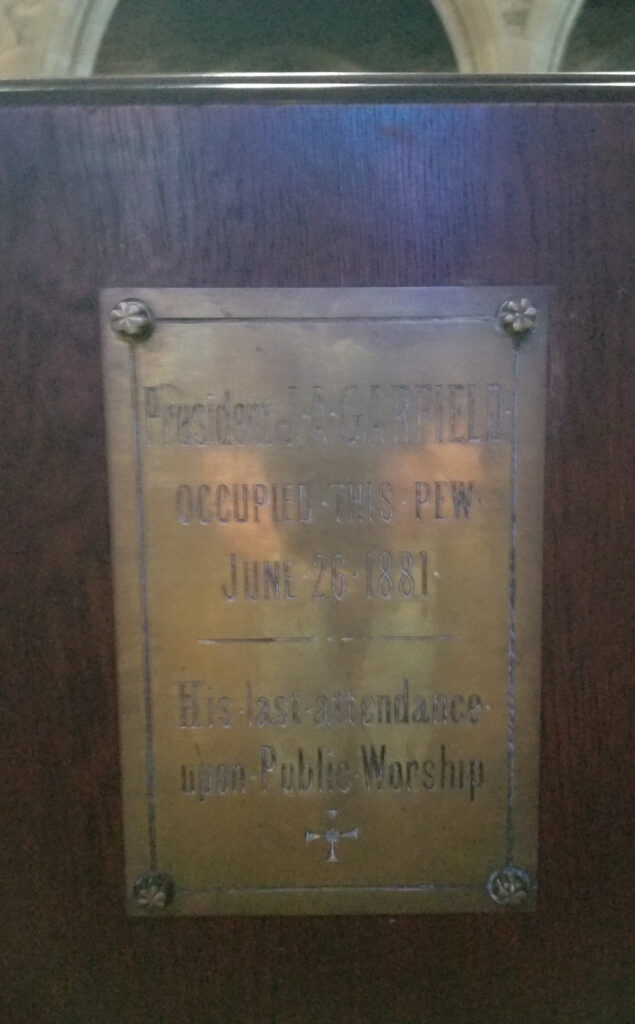
Visitors staying at beach resorts had to take horse-drawn carriages and such in order to attend worship services at the Church, a trip that could take more than an hour each way from, say, Elberon. Well-heeled summer regulars prevailed upon the Church, which was persuaded to open a seasonal branch on the beach. This is what became the St. James Episcopal Chapel, at 1260 Ocean Avenue in the Elberon section of Long Branch, about four miles away from the Church. The Chapel was consecrated in 1879 – two years after Grant left office following his second term – so while it is a fact that he summered in Long Branch for eight years, it is quite impossible for him to have ever attended services at the Chapel while president, as has been claimed.
There is a cache to a place being chosen by a sitting United States president to serve as the official summer residence, the “Summer White House,” as can be legitimately claimed by Long Branch in the case of Grant. Such places retain that appellation which is typically a source of great regional pride. In my view, a claim that a president summered at, or visited a certain place, when referring to someone who is a former president, that is still a valid claim, albeit, one that warrants clarification. The same cannot be said of a future president who visits a place. A location cannot be considered a place of presidential residency unless a sitting or former president visits. Therefore, we will clarify when a presidential visitation claim involves a future, sitting, or former chief executive.
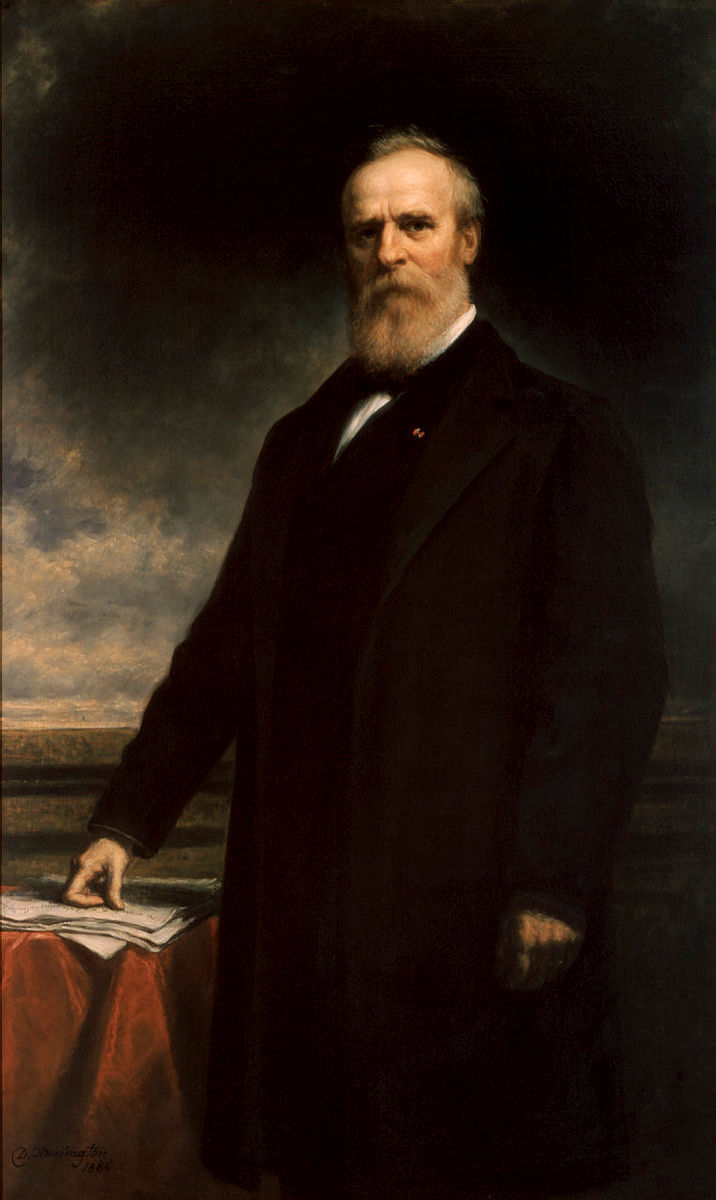
Rutherford B. Hayes, 19th president, in office March 4, 1877 – March 4, 1881.
A newspaper in Passaic, N.J., reported in 1879 that “The Ocean Grove people are ecstatic with happiness over the acceptance by President Hayes of the invitation of the Rev. Dr. Stokes, President of the Ocean Grove Camp Meeting Association, to be present at the tenth anniversary of their first religious services, on July 30.” Hayes did not attend that event.
According to the Rutherford B. Hayes Presidential Library, Hayes was baptized as a Presbyterian in Ohio and held complex religious views. He was a deeply spiritual man who attended church every Sunday with his wife and children and studied the Bible. During his presidency, he and his cabinet began each day by praying together and reading the Bible. Many of them also joined the Hayes family on Sunday nights in singing hymns. And he gave money to support area churches, especially the Methodist church in Fremont, Ohio, his hometown, and the site of his summer White House. Throughout his adult life, however, Hayes repeatedly said he was not a Christian.
“I am not a subscriber to any creed,” he wrote in 1890. “I belong to no church.” Later in the same entry, however, he writes: “I try to be a Christian, or rather, I want to be a Christian and do Christian work.”
Hayes may have written more about his personal religious thoughts than any other American president. His thoughts were often contradictory, as his diary entry from 1890 shows. His views on religion evolved and changed over time.
But the important fact is that Hayes kept a diary, from his youth until his death. And it contains no entries anywhere indicating that he ever visited any part of Monmouth County, as president, before, or after.
Hayes’s diary contains no entry for July 30, 1879, the date he supposedly participated in the anniversary ceremonies at Ocean Grove. But his entries for that time frame are highly suggestive of where he was during that period. For example:
Soldiers’ Home, July 7, 1879. – We came out to the Home for the summer on our return from the “ocean voyage” Saturday evening, July 5.
July 26, 1879. – Parton in an article in the Magazine of American History says Washington was in favor of a single Presidential term of seven years… (The entry goes on to discuss presidential term limits).
Soldiers’ Home, August 1, 1879. – The death of Judge Collins is surprising and a great calamity to his family and my friends…
“The Soldier’s Home” is now called the Soldiers’ Home National Monument, located near Brookland in Washington, D.C. The Soldier’s Home was created as an asylum, a place of rest for disabled soldiers after the Civil War. James Buchanan chose a cottage on the grounds of The Soldier’s Home for his Summer White House. Abraham Lincoln summered there in 1862, 1863, and 1864. Hayes’ diary clearly indicates The Soldier’s Home was likewise his chosen Summer White House, for his third year in office.
There is no evidence of any kind to support any of the claims that Hayes is one of our famous Seven Presidents. He did not summer here, nor did he vacation here, nor did he visit Ocean Grove in any capacity, nor did he attend church services anywhere.

James A. Garfield was our 20th president, and served from March 4, 1881 – September 19, 1881.
Garfield and his wife Lucretia were reported to have summered at a hotel on Main Street in Ocean Grove while he was a member of Congress from Ohio.
Early in his truncated term as president, Garfield’s wife Lucretia contracted malaria in the sweltering humidity of Washington, D.C. In those days, it was widely believed that the fresh ocean breezes of the Jersey Shore held certain restorative healthful qualities. From June 18 – July 2, 1881, Lucretia Garfield was in Long Branch, staying at the Elberon House Hotel, along with daughter Mollie and friends. The President came with her for the first part of the trip, then returned to Washington. According to the Ocean Grove Record:
Saturday, June 18, the first through express of the season left West Philadelphia for Ocean Grove and Long Branch. President Garfield Family in a special car. The president kept himself aloof from observation until the train stopped at Asbury Park depot. Here, while it was being nearly emptied of its passengers, President Garfield looked out to get a glimpse of this place, the growth and prosperity of which has been so marvelous.
It was at this point that the Times reported that former President Grant arrived for a return visit to Long Branch. He stayed at the Elberon Hotel where the current president, Garfield, was staying with his family. The Grants visited the Chapel, while the Garfields went to the main church for Sunday services.
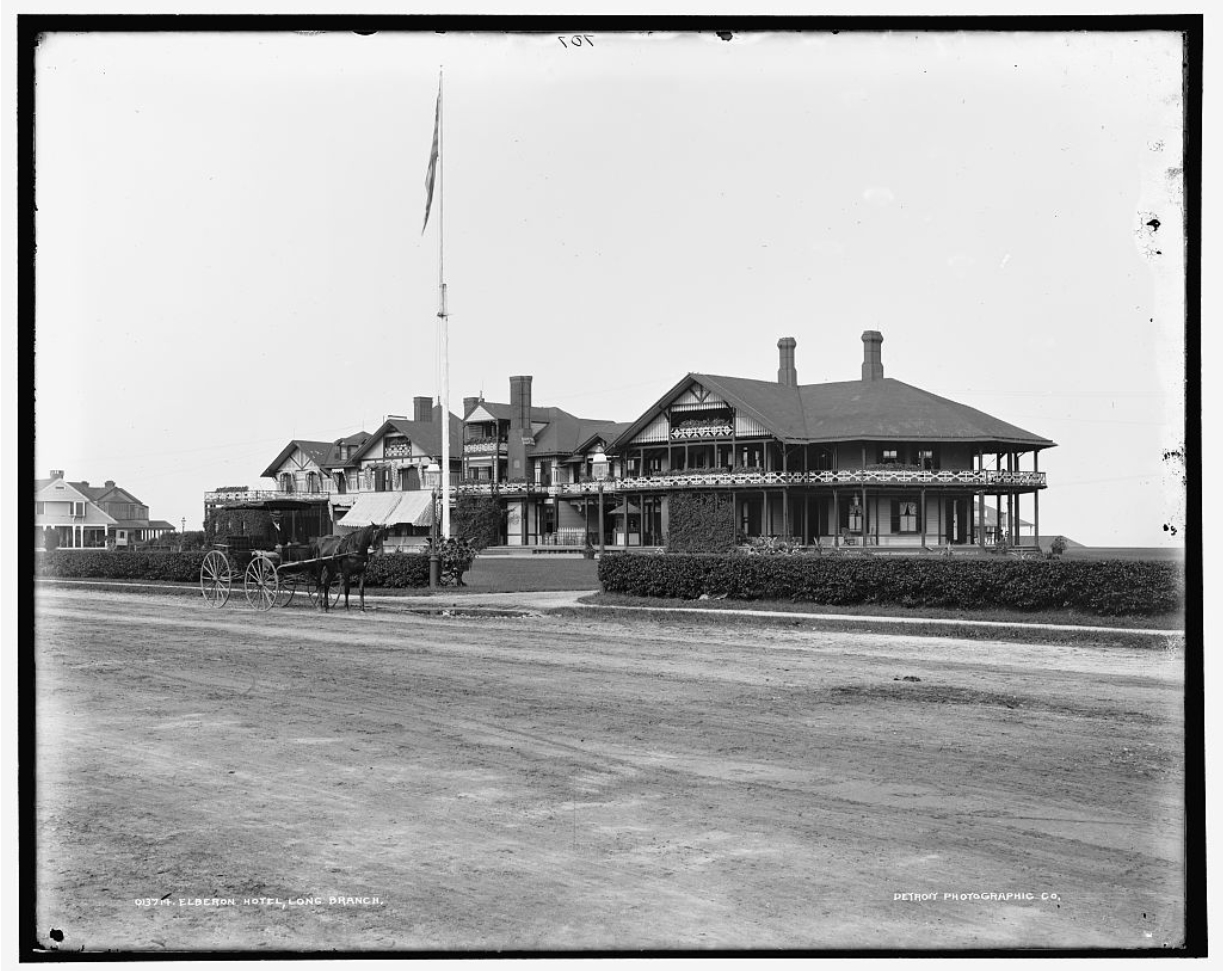
Garfield was staying in the Elberon Hotel proper, while the Grants were staying in one of the “cottages” on the property. Garfield and his wife were both devout members of the Christian Church, then known as the Disciples of Christ. It is not known why he chose the long trip to the Episcopal Church over the short walk to the Chapel, or to some other house of worship.
On June 22, 1881, in Cleveland, Ohio, President Garfield’s uncle was killed in an accident involving a train and a horse-drawn buggy. Newspaper coverage noted that “President Garfield…[was] telegraphed to at Long Branch.” That same day, June 22, newspapers reported that Garfield’s cabinet secretaries had arrived in Long Branch, to conduct the affairs of the government.
Garfield returned to Washington in late June, and it was public knowledge that he would return to his family in Elberon on July 2. On that day, an assassin waited in hiding at the train station, and while the president was talking with others, shot Garfield twice, with one bullet lodged in the president’s back, a wound not immediately fatal.
President Garfield’s recovery was hindered by the typically brutal summer weather in the nation’s capital. His doctors and family agreed he should be moved to Long Branch for the restorative ocean breezes. The lack of sanitation in medical practice at the time, however, eventually led to his death.
After Garfield died, local newspaper coverage focused on Long Branch having been the chosen summer residence for both Grant and Garfield, and began conflating the two Long Branch Episcopal houses of worship, and stating that both Grant and Garfield had attended services at the Chapel while president.
Garfield vacationed in Long Branch for a brief period, and attended church services at the St. James Church on Broadway, as sitting president. He was in Ocean Grove prior to serving as president. It is entirely possible that he did visit the Chapel, but there is no evidence of this.
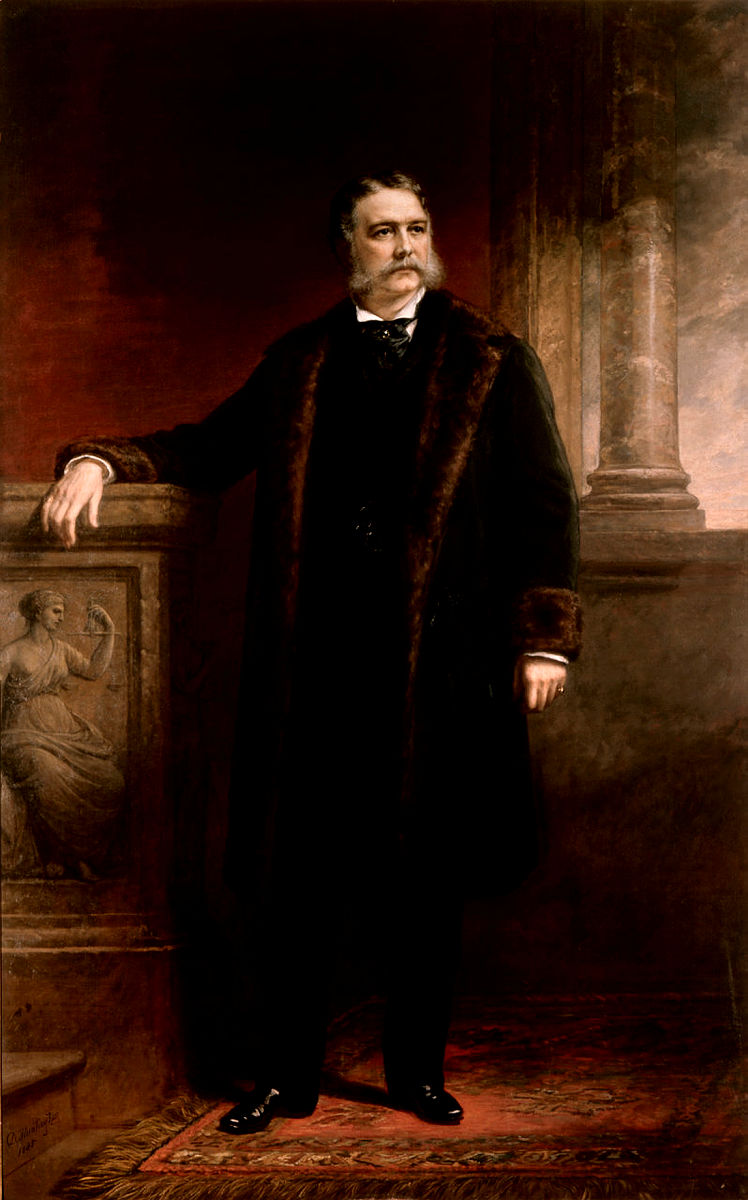
Chester Alan Arthur, 21st president, in office September 19, 1881 – March 4, 1885.
In 1910, the Monmouth Democrat reported that: “Chester Allen [sic] Arthur, who succeeded the lamented Garfield, spent two summers at the Monmouth House, Spring Lake Beach, while collector of the Port of New York, just preceding his election to the vice presidency.” This means Arthur would have been in the area in 1877 and 1878. After Garfield died, Vice President Arthur came to Long Branch to visit the President’s widow. Later that day he returned to his residence in New York City to take the oath of office, succeeding Garfield as president (which was the objective of Garfield’s assassin all along, to put Arthur in office). The following day, Arthur returned to Long Branch to board the train that carried the body of the former president, and his family, as they were carried away for funeral services.
Chester A. Arthur was a native of Vermont, the son of a Baptist minister who became an Episcopalian. There is evidence that Arthur purchased a lot on Park Ave in Long Branch, but no evidence that he ever built anything on it. He may well have attended church services while summering at Spring Lake Beach before attaining national office, but he did not spend any summers, or vacation time, at Long Branch or in Monmouth County during his sole term as chief executive. We have yet to unearth any documentation of where or when Arthur may have worshiped during his stay at Spring Lake Beach.
Arthur’s case is useful for considering whether or not it’s valid to claim a presidential visit from a person not yet elected to that office. Arthur summered in Spring Lake Beach as Port Collector, but did not return to Monmouth County for vacationing either as president, or following his one term in office. Would it be legitimate for Spring Lake Beach to call itself a place where a president once vacationed? (They do not, so, thankfully, it is merely an academic question.)
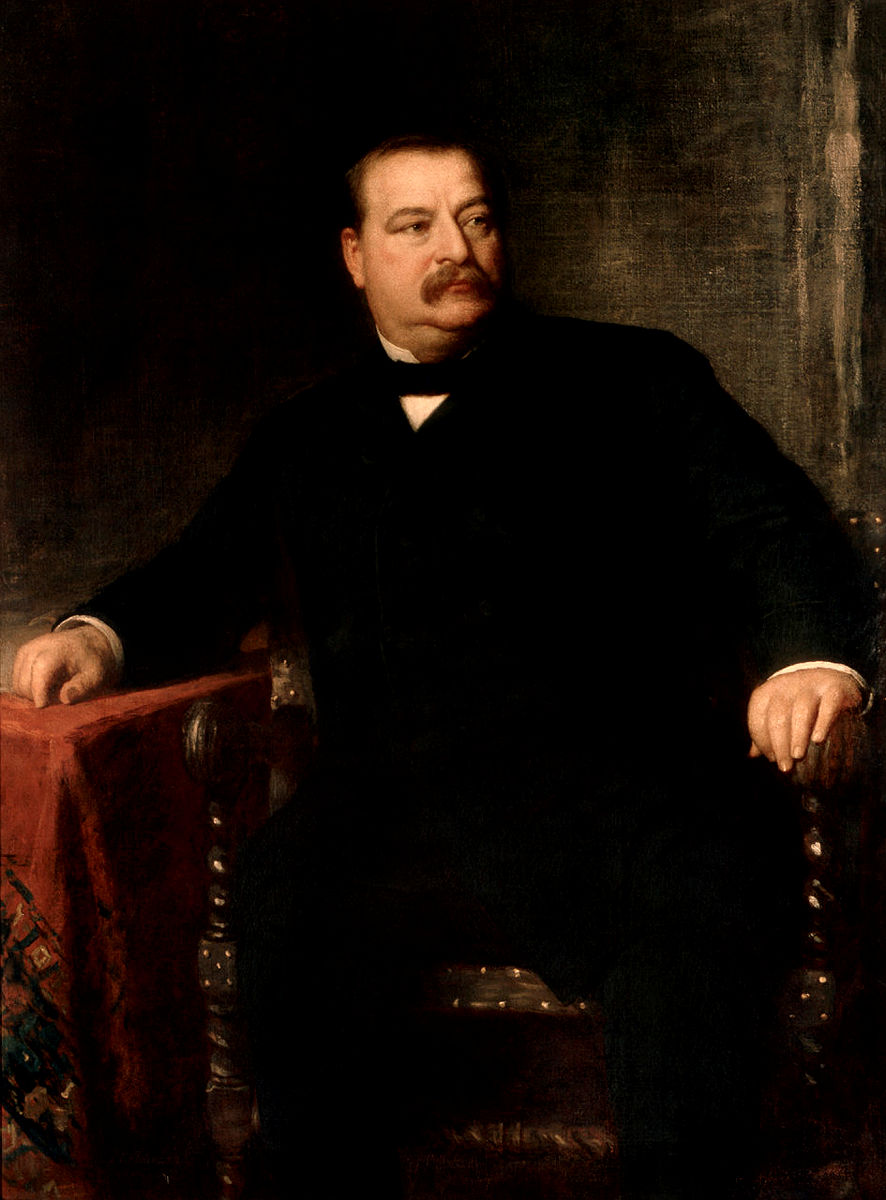
Grover Cleveland, 22nd and 24th president, in office March 4, 1885 – March 4, 1889, and March 4, 1893 – March 4, 1897.
Grover Cleveland succeeded Chester A. Arthur as president, serving one term from 1893 – 1897. He lost his re-election bid to Benjamin Harrison, who became our 23rd president, but Cleveland was elected to the White House again in 1885, making him the only president to serve two non-consecutive terms.
Cleveland, born in Caldwell, is the only native of New Jersey ever to be elected president; after the end of his second term in office as president, he retired to Princeton, in nearby Mercer County, where he lived until his death in 1908.
Cleveland is not claimed by anyone to have been among the U.S. presidents to visit our area, save for a single story in 2000 in the Asbury Park Press, which noted that seven presidents had been among the famous people who spoke at Ocean Grove events. This list excluded Garfield, but included Cleveland. This is another example of a single newspaper account serving as sole documentation of a claim for which no evidence has yet been found.
Despite his Garden State heritage, Cleveland was more of a New Yorker, serving as governor of New York after having been mayor of Buffalo. It seems hard to believe that at no time did Grover Cleveland ever step foot in Monmouth County, but no convincing evidence exists to place him here at any time.
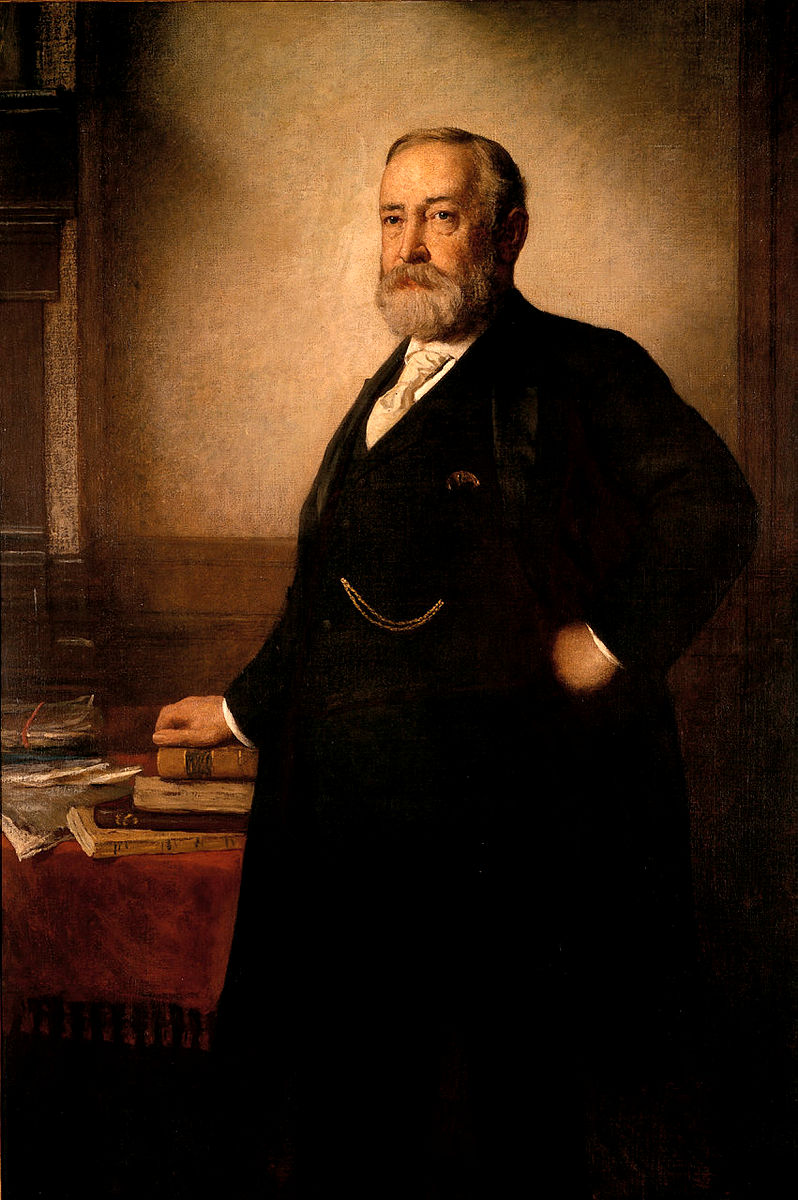
Benjamin Harrison, 23rd President, in office March 4, 1889 – March 4, 1893.
While president, Benjamin Harrison, a native of Indiana, summered at Cape May, which had been the summer residence of previous U.S. presidents. There is no record of him spending any time in Monmouth County while he was president.
Five years after completing his one term as president, on July 7, 1898, former president Benjamin Harrison stayed at the Elberon Club in Long Branch.
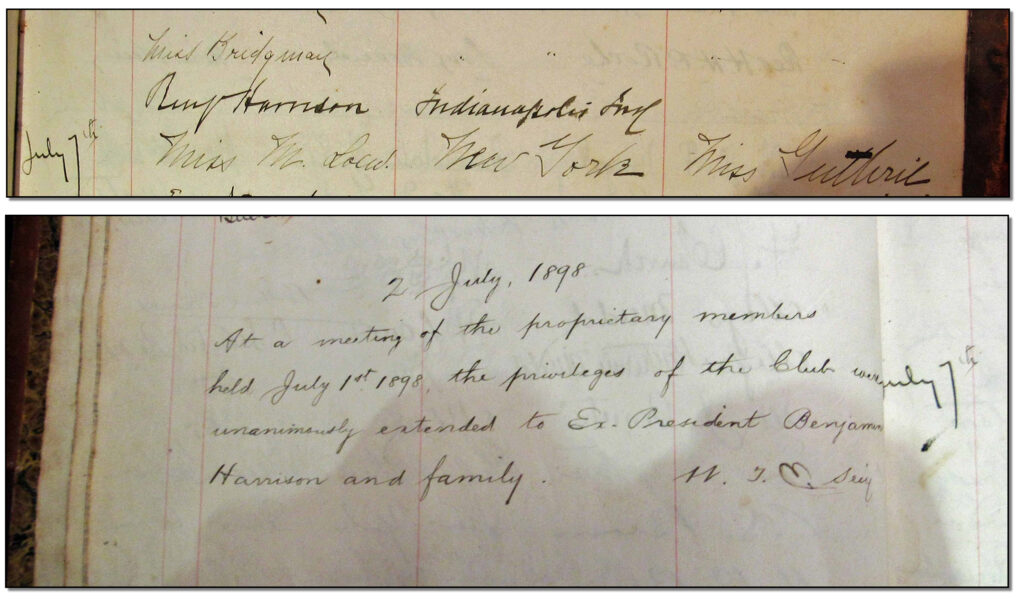
A club journal entry dated July 2, 1898, reads, “At a meeting of the proprietary members held July 1st, 1898, the privileges of the Club were unanimously extended to Ex. President Benjamin Harrison and family.”
But almost 30 years later, in 1927, after the prestigious Monmouth Beach Inn was lost to a fire, local newspapers reported that “President Benjamin Harrison spent his summers in a cottage on the circle during the gay nineties…” The reference to “circle” indicates what was then known as “Clubhouse Circle,” a group of separate cottages on the grounds of the Inn. This is another example of a single newspaper report being the only supporting documentation of a claim. It is possible that this reference to the Monmouth Beach Inn may have meant a summer residence for the former president rather than the sitting president.
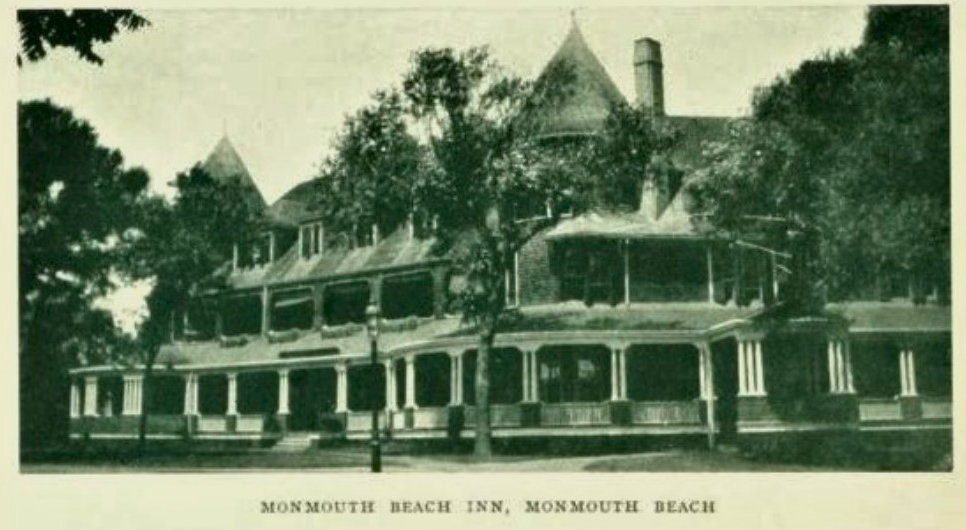
On September 16, 1927, not long after the Monmouth Beach Inn fire, a woman wrote a letter to the editor of The Daily Record saying that Harrison, a devout Presbyterian, had attended church services at the St. James Chapel on more than one occasion:
According to Mrs. W.H. Ebeling, of Lake Openaka, Dover, President Benjamin Harrison attended St. James’ Chapel, Ocean Avenue…one or more times while he and Mrs. Harrison were guests at the Elberon Hotel. Harrison visited the North Jersey shore along in the early nineties and once stopped with friends at Monmouth Beach. The date cannot be recalled.
Mrs. Ebeling’s letter also stated that “between 1892 and 1900,” her father was a member of the Chapel vestry. It would be three years before Harrison would finally become anointed as the seventh of the Seven Presidents, during which time apparently other “family members” wrote letters asserting that he had visited the Chapel.
In any event, Harrison clearly did spend time in Monmouth County as former president, in Elberon, on vacation.
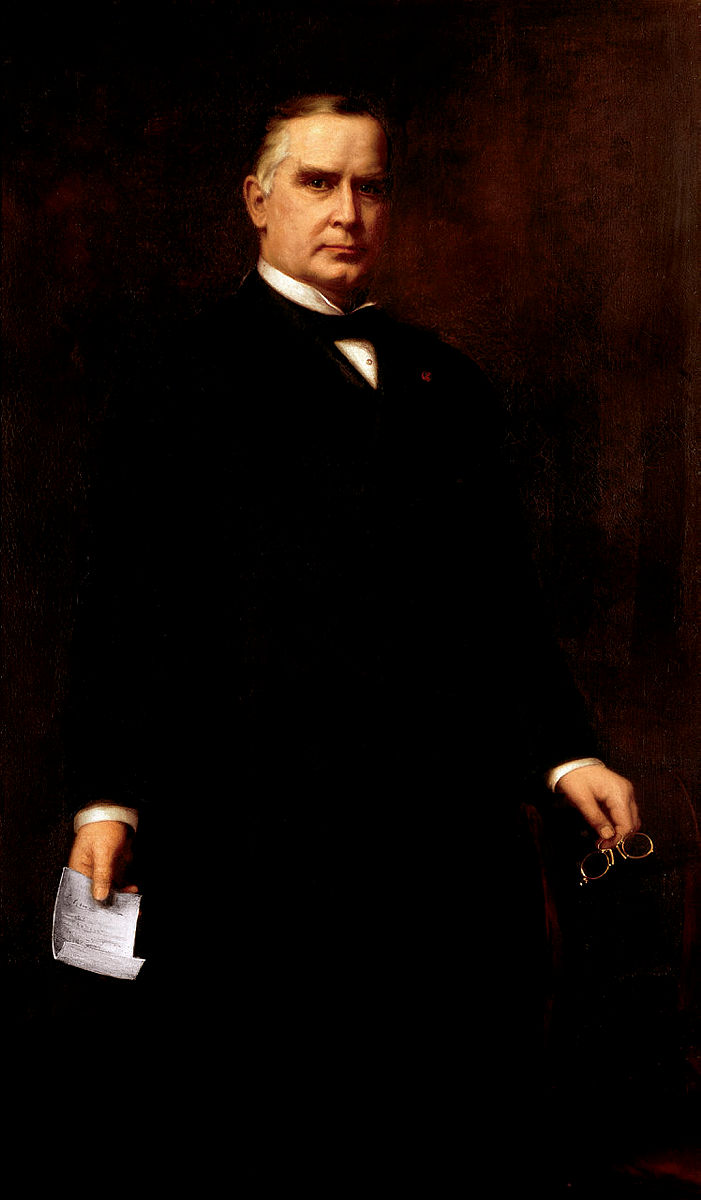
William McKinley, 25th president, in office March 4, 1897 – September 14, 1901.
On Friday, August 25, 1899, U.S. President William McKinley gave a speech at the Ocean Grove auditorium, following a presidential parade through the streets of Asbury Park, during his one and only term in office. Like Garfield, McKinley died in office from an assassin’s bullet. McKinley was also in Monmouth County to be with his ailing vice president, Garrett Hobart, who had a summer home in the Norwood Park neighborhood of West Long Branch, called Normanhurst.

After his public appearances, the president spent the night at Normanhust, and then he and his group boarded a train in the morning and headed to Harrisburg, Pa. In the very detailed newspaper coverage of his visit to Monmouth County, there is no mention of McKinley attending church services while he was here.
McKinley, a Methodist from Ohio, chose the Champlain Hotel in Plattsburgh, N.Y. as his Summer White House.
McKinley is included in all claims in our region involving visiting presidents, but there is no evidence of him spending any vacation time in Monmouth County, nor of attending church services anywhere.
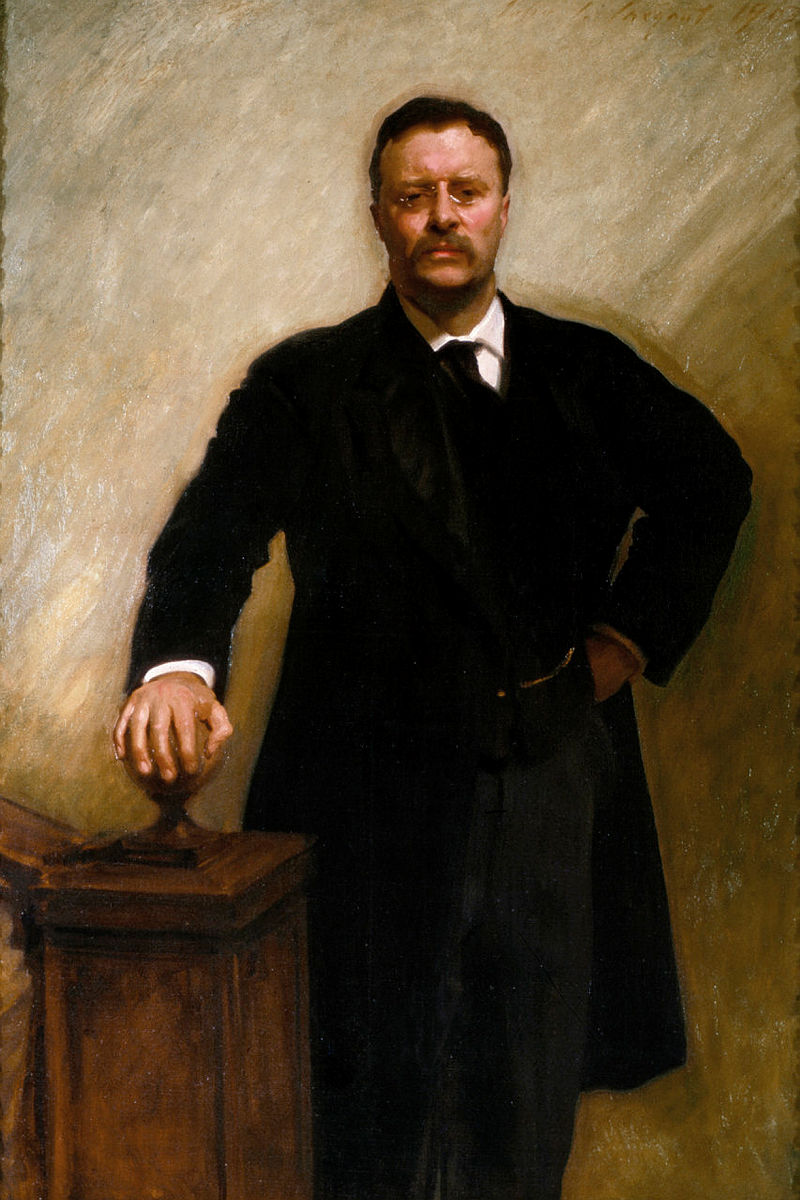
Theodore Roosevelt, 26th president, in office September 14, 1901 – March 4, 1909.
On July 7, 1905, U.S. President Theodore Roosevelt addressed the National Education Association in the Great Auditorium. Roosevelt, who had spoken at the Auditorium four years before being elected, was greeted by thousands who lined the streets in Asbury Park and Ocean Grove to see the president in a horse-drawn carriage on his way to the venue.
Roosevelt’s preferred summer residence while president was his family home in Sagamore Hill, Cove Neck, New York. A member of the Dutch Reformed church, Roosevelt occasionally attended Episcopalian services when no Dutch Reformed facility was available.
Roosevelt is included in certain Seven Presidents claims, such as those of Ocean Grove, and is included in several “seven presidents” stories published over the years in The Daily Record, but he is excluded from others, such as the St. James Chapel.
A Monument to Garfield
The Garfield Monument Association was organized in August 1906 to raise money for a statue of the martyred president in Long Branch; five years later, funds were finally allocated. On September 2, 1918, the statue of Garfield by sculptor Carl Schweizer was erected at Garfield Park at City Stadium, at Broadway and Ocean Avenue. The statue was made to honor the assassinated president on the 25th anniversary of his passing. In 1959, the statue was moved to the Boardwalk at the end of Laird Street, where it remains today, surrounded by a set of bronze tablets commemorating the other “original six” presidents, i.e., Grant, Hayes, Arthur, Harrison, McKinley, and Wilson.
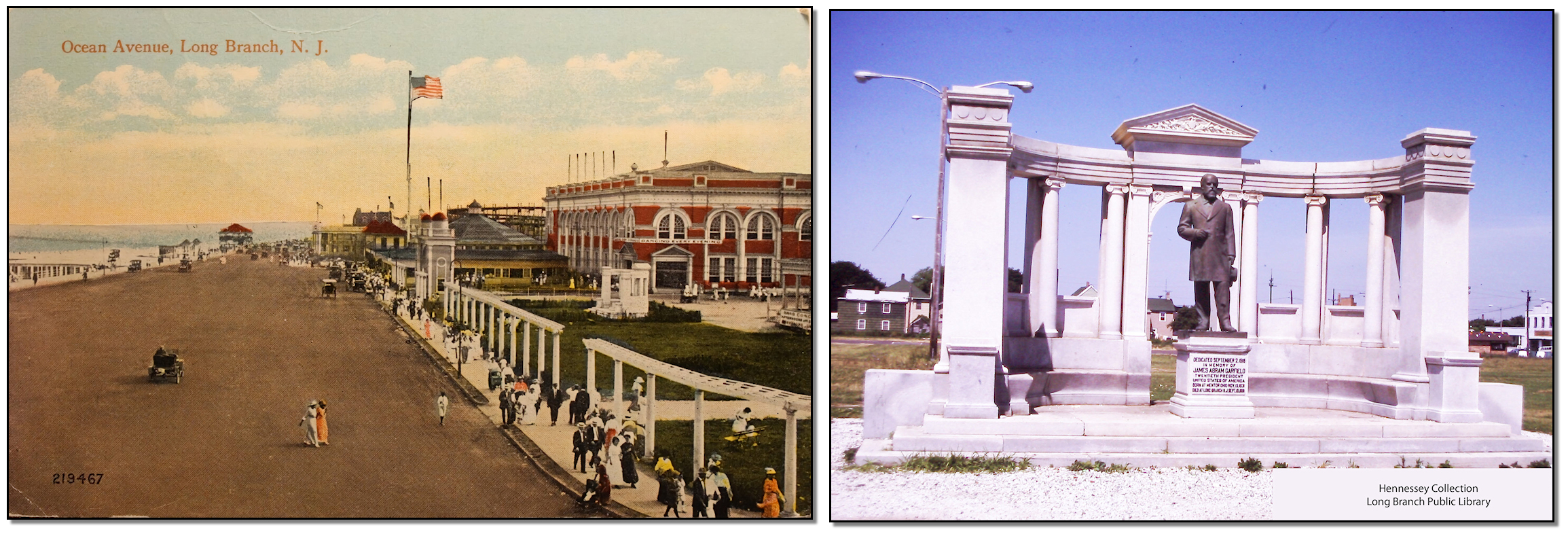
These tablets have a whole set of mostly new, and mostly bogus claims: Grant “Vacationed for 12 years;” Hayes “summered at the Elberon Hotel;” Arthur “Leased a cottage on Park Avenue;” Harrison “Vacationed at Long Branch;” McKinley “Summered at a cottage located at the Elberon Hotel; and Wilson “Summered at McCall’s Shadow Lawn.” There is a Park Avenue in Spring Lake, and a completely different Park Avenue that extends from Elberon west, it’s not clear from the tablet which town may have been the location of Arthur’s cottage. It’s possible that the Arthur claim refers to him before he was president.
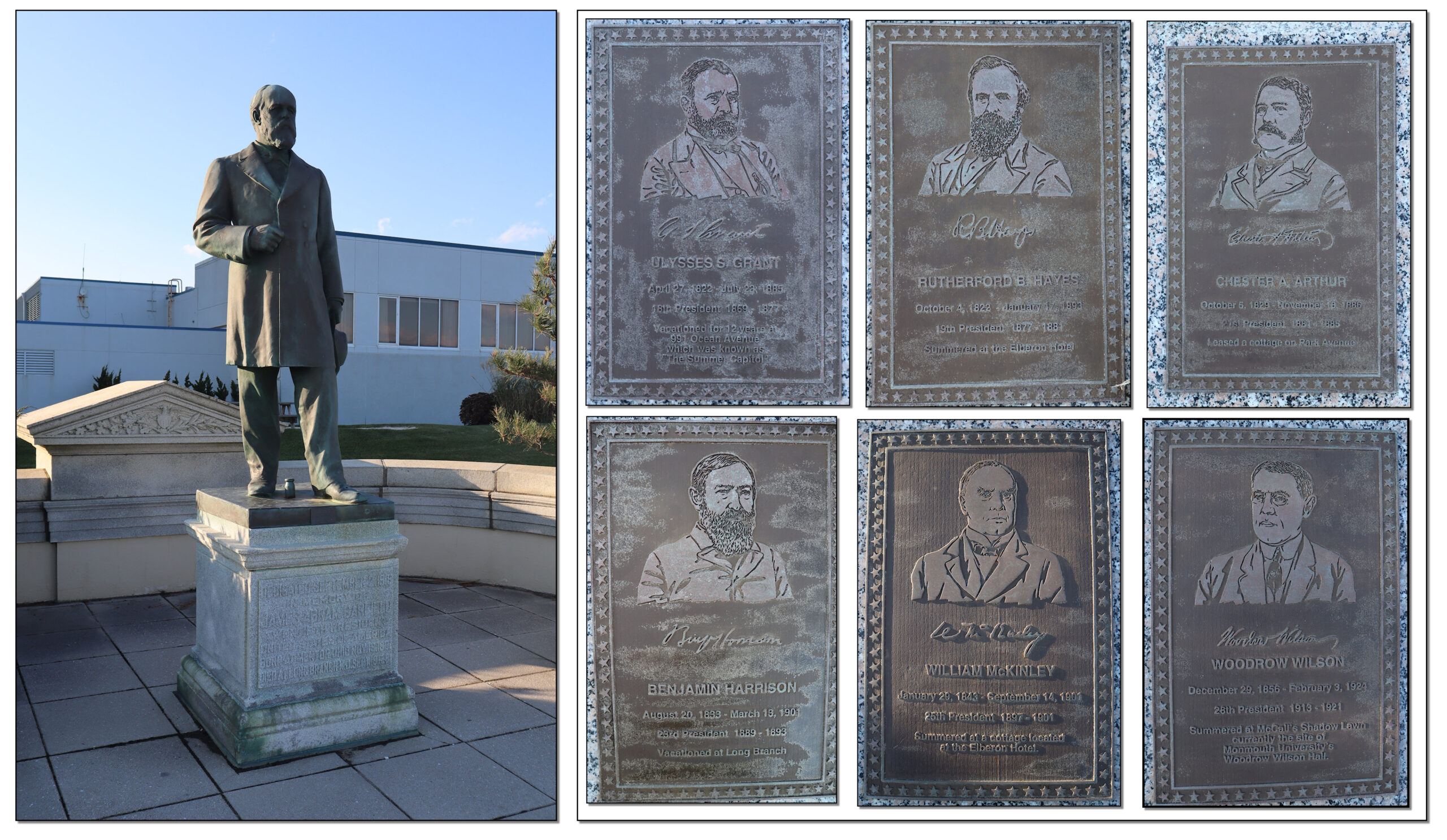
Of those, the Wilson claim is legitimate, as is the Harrison claim assuming it refers to him as past president, but the others are all unsupported by any evidence.
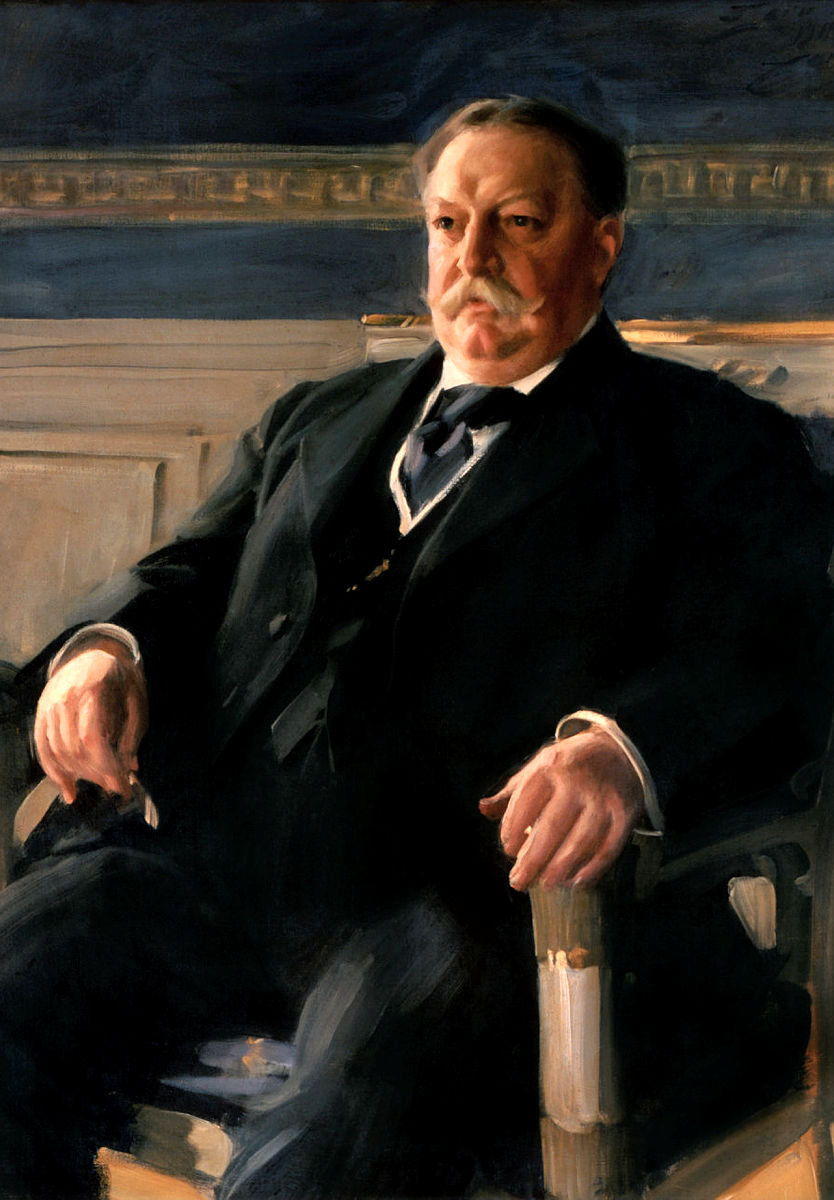
William Howard Taft, 27th president, in office March 4, 1909 – March 4, 1913.
On Tuesday, August 15, 1911, U.S. President William Howard Taft gave a speech at the Ocean Grove auditorium during his one and only term in office. It was not noted if he attended any church services while he was there.
A Unitarian from Ohio, Taft’s summer residence was his family’s home in Cincinnati.
Taft is rightfully included among the presidents of Ocean Grove, but he is not claimed by Long Branch nor the St. James Chapel.
The Five Presidents of Long Branch
In addition to the promotional efforts by the St. James Chaplain, civic boosters were making various vague references to “five presidents” on behalf of both Long Branch as well as Ocean Grove.
In 1911, at the same time that the funds for Garfield’s monument were being approved, Long Branch Mayor Edwin W. Packer invited a Japanese admiral who was making a tour of the U.S. to join New Jersey Governor Woodrow Wilson at a children’s pageant in Long Branch, “which has twice been the summer capital of America and the home of five presidents…” The Admiral expressed his regrets that he was unable to change his schedule in order to attend. The five presidents were not named.
In 1914, the residents of Ocean Grove voted on whether to become a borough with an elected government, or remain under the leadership of the Ocean Grove Council. Proponents on both sides ran large display ads urging citizens to vote for or against “the Borough law,” and both sides noted that “Five presidents of the United States have been received and honored” at the Great Auditorium of Ocean Grove.” These five presidents are never named.
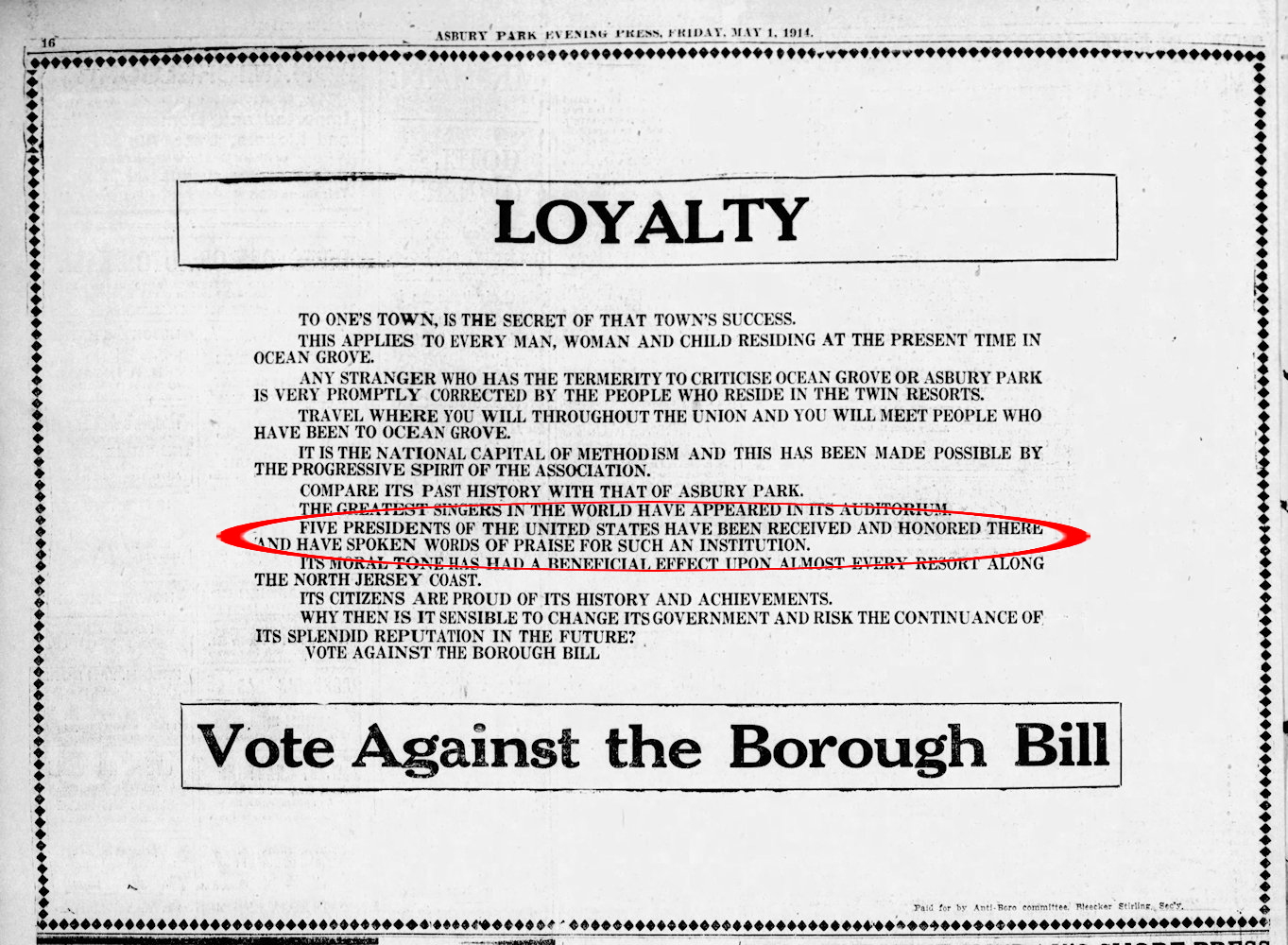
In 1918, The Daily Record, Long Branch’s daily newspaper, ran a small rectangular graphic in the upper right corner of the front page stating, “Long Branch, the Summer Home of Five Presidents, and the Best Place in Monmouth Co. for Live Propositions to Locate at.” Those presidents are also not detailed by name.
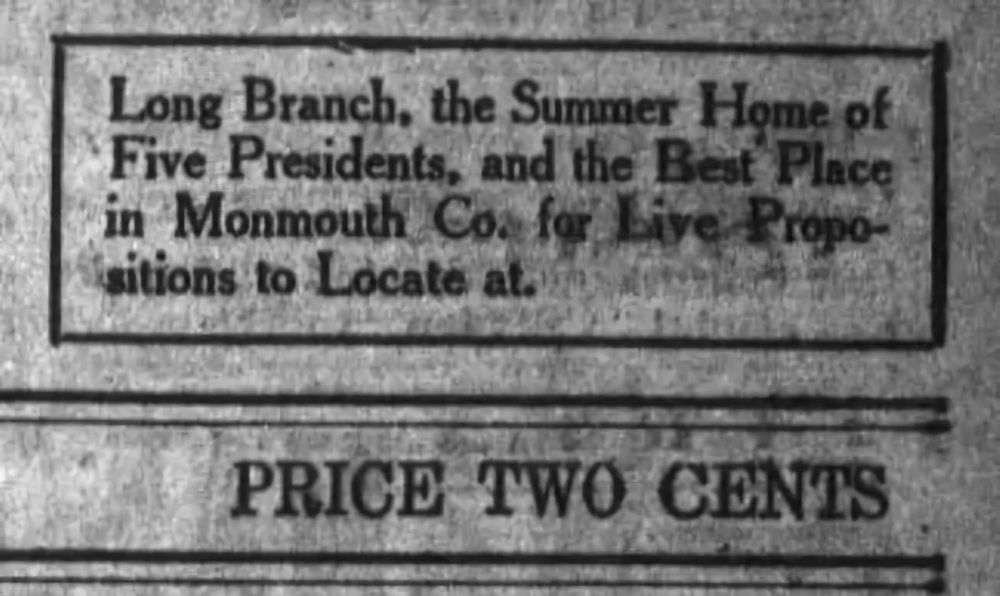

Woodrow Wilson, 28th president, in office March 4, 1913 – March 4, 1921.
Aside from Grant, no other president is as prominently associated with Monmouth County and Long Branch as Woodrow Wilson. The former governor of New Jersey, and president of Princeton University, chose Shadow Lawn, a mansion located at Cedar and Norwood Avenues in West Long Branch, as the site for his declaration of his bid for presidential re-election, and made it the Summer White House for his second term.
Wilson, a Presbyterian whose father was a theologian, had an upbringing steeped in religion, and remained deeply religious throughout his life. He was a frequent church-goer, and read the Bible regularly, especially toward the end of his life. He was known to have attended church services at the St. James Episcopal Church on Broadway in Long Branch, where a bronze plaque marks the pew where he and his family sat.

Woodrow Wilson is included in virtually all Seven Presidents claims. He summered in West Long Branch during his second term. He visited Ocean Grove as governor, before being elected president. He attended services at the Church while president, but there is no evidence that he ever chose to attend services at the Chapel.
The Events of 1925
Over the years, new houses of worship were erected along the shores of Monmouth County, giving summer visitors more convenient options for Sunday services. The financial base for the St. James eroded slowly, and the Chapel finally faced financial catastrophe.
In 1925, St. James Episcopal Chapel was facing an order to pay $650 for a road assessment, which was a lot of money at a time when the chapel had dwindling financial support. “The chapel is worth saving,” said Chaplain Haywood L. Winter, suggesting that the assessment threatened the very existence of the Chapel. That assessment, $650, would amount to approximately $12,000 today, but Winter didn’t have anywhere near that amount. Things had gotten so bad that Chaplain Winter served without compensation.
On July 29, 1925, The New York Times reported on page one that the funeral services to be held for William Jennings Bryan, the popular orator and politician, would take place at St. John’s Episcopal Church in Washington, D.C., directly across Lafayette Square from the White House. The Times referred to St. John’s as the “Church of the Presidents,” a designation St. John’s had acquired owing to the many chief executives who had attended church services there over the years. At this time, no one had ever used that phrase publicly to describe St. James in Elberon, but that would change quickly.
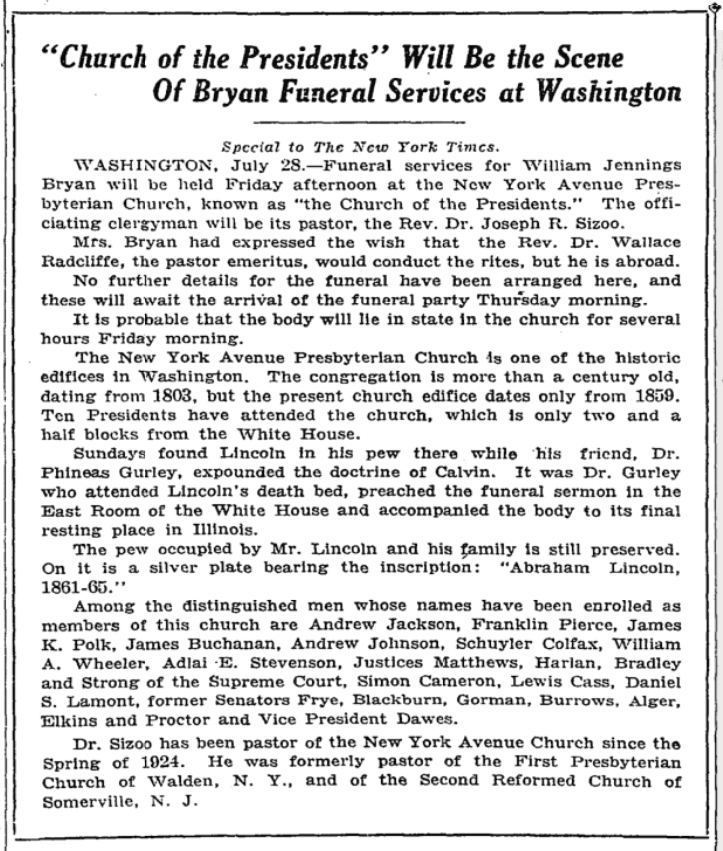
The following day, July 30, a small announcement in The Daily Record announced that memorial services would be held at the St. James Chapel, but now, for the first time, calling it “The Church of the Presidents.” Just a week later, August 7, 1925, Chaplain Winter announced that the Chapel would hold a special memorial service on Sunday, August 9, for President Grant, noting that the church had a bronze tablet to honor the president, who had worshiped there while president. In the newspaper account of Winter’s announcement, the Chapel was called, “The Church of the Presidents.”

The day after the Grant service, August 10, 1925, The Daily Record ran a brief story about Chaplain Winter’s efforts to save the Chapel. Up until this point, there have only been two presidents associated with the Chapel, Grant and Garfield. On this day, the Long Branch paper of record stated that the Chapel had been the “worshiping place” for Grant, McKinley, and Wilson.
In just a matter of days, the Chapel’s claim of two presidents had been doubled, thanks to the local newspaper. From that point forward, until 1925, the Chapel would claim those four presidents as having worshiped there while in office.
Haywood L. Winter – a former chaplain at Fort Monmouth – may have had many talents and abilities as a clergyman, but he certainly proved to be a shrewd judge of what might appeal to popular interest.
On August 12, 1925, the Asbury Park Press announced a new public campaign to raise funds to save the Chapel. The Press emphasized the importance of preserving what was “the place of worship of Grant, Garfield, McKinley and Wilson.” Others did likewise, each and every one now never failing to refer to the Chapel as the “Church of the Presidents.” But during this initial time, there was a consensus that four presidents were the source of this claim: Grant, Garfield, William McKinley and Woodrow Wilson.
On August 15, Winter announced that the Chapel would hold a memorial service for James A. Garfield. Winter’s announcement in the newspapers once again referred to St. James as “The Church of the Presidents.” At each service during this period, Chaplain Winter continued to stress the financial plight facing the Chapel, and pleaded for help from the public.
Heroes Emerge from Long Branch’s Jewish Community
On August 24, 1925, during the Garfield memorial service, the congregation at the Chapel was stunned when a man named Bernard Sandler stood and approached the pulpit, interrupting the sermon. Sandler introduced himself, and said he was there representing Ernest Levy, co-builder of the just-opened West End Casino, and that they had learned of the financial plight of the Chapel. Sandler said, “While we are of another faith, we worship the same god,” and that he and Levy, both Jewish, felt strongly that the Chapel deserved to be saved, and so Levy donated a check for the full amount of road assessment money owed by the Chapel. During his address to the congregation from the floor, Sandler, a criminal defense attorney by trade, remarked that the Chapel was nothing less than “the Westminster Abbey of America,” and that it had been a place of worship for six presidents: Ulysses S. Grant, Rutherford B. Hayes, James A. Garfield, William McKinley, Chester A. Arthur, and Woodrow Wilson.
Until Bernard Sandler made his assertion, no one had ever before claimed that six presidents had attended services at St. James. There was a consensus, whether valid or not, around four: Grant, Garfield, McKinley, and Wilson. Hayes and Arthur were new to the list. By that time, the Chapel had a bronze tablet commemorating Grant, and another for Garfield.
The new sobriquet worked astonishingly well for the Elberon Chapel and its chaplain. While Levy and Sandler had covered the Chapel’s road assessment fee, the other funds raised by the community helped cover badly needed renovations and improvements. And St. James was now known in virtually all references by its new appellation, “The Church of the Presidents.”
Who WERE Bernard Sandler and Ernest Levy?
Bernard Sandler was a New York City criminal defense attorney who had a summer home at 69 Cottage Place on the corner of Second Avenue in Long Branch. Despite being a summer resident, Sandler was active in Long Branch community activities over the years.
Less is known about Ernest L. Levy of Newark, but he purchased the H.J. Braker cottage in Norwood Ave, in West End, and later bought the estate of E.V. Thebaud, deceased, “adjoining Shadow Lawn and the Guggenheim estates.”
Levy and Louis Funcke were the primary partners in a new resort called the West End Casino. While Funcke was president of the company, Levy was the public face of the firm and received most of the adulation for birthing this edifice.
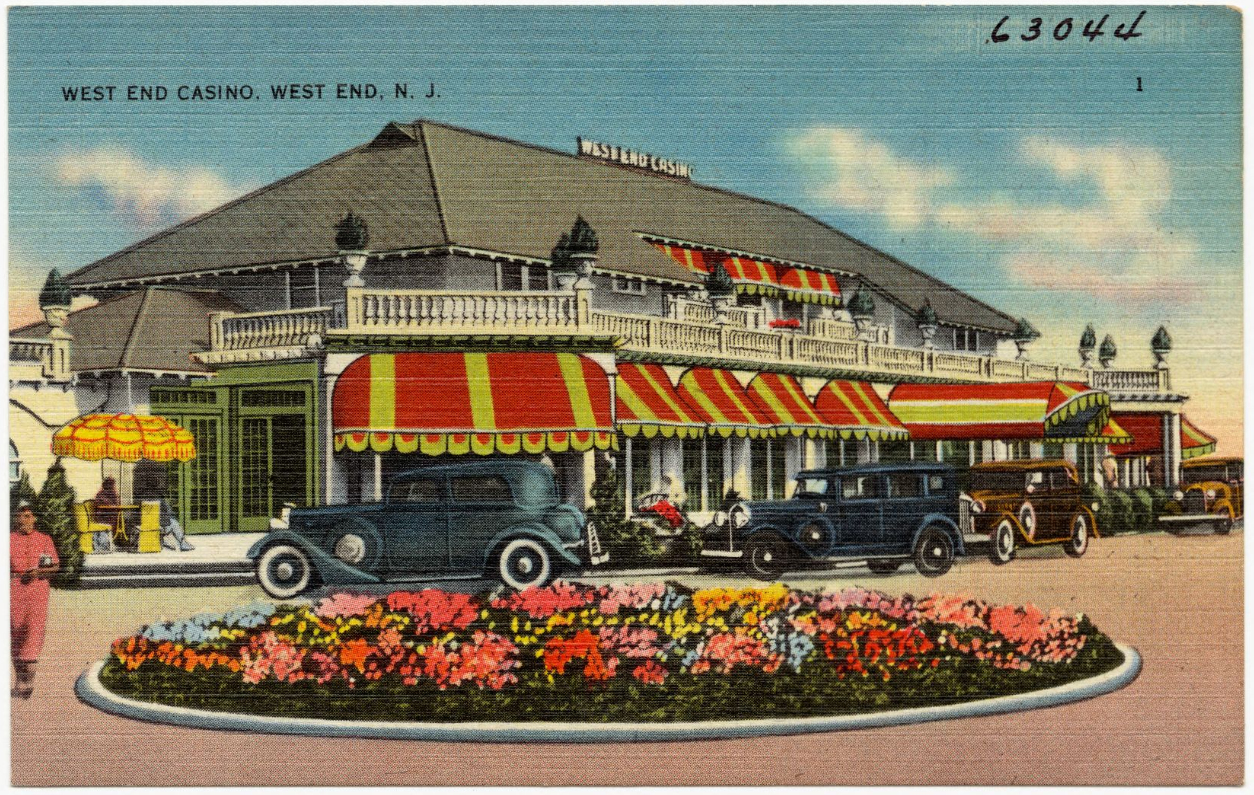
The West End Casino was planned as a $200,000 resort with 400 bath houses and two swimming pools, and 325 feet of boardwalk along the ocean. The resort opened June 20, 1925, and enjoyed considerable prosperity for many years.
In 1947 Levy sold his interests in the casino. On January 1, 1953, the Casino, along with three other properties, were sold by a broker to the Tisch Management Company, operator of many other hotels and resort properties. The Casino closed at the end of the 1964 season and it was announced that it would reopen as the West End Racquet Club.
Clearly, the donation to the Chapel was a publicity stunt, but at the same time, until Bernard Sandler presented Levy’s check, the fact remained that while monies were being raised for the Chapel, no one had yet given Chaplain Winter a penny. Their gesture brought the West End Casino considerable favorable coverage, while serving as a strong statement of community solidarity. It was another loud statement that the Chapel was considered a critical part of the town and was deserving of better preservation.
Bernard Sandler and Ernest Levy deserve to be better remembered for the gesture of community support they made in 1925.
Benjamin Harrison (finally) Joins the Club
On August 28, 1927, four new bronze tablets arrived in Elberon, one each for Hayes, Arthur, McKinley, and Wilson, to be installed in the St. James Episcopal Chapel, joining those already in place for Grant and Garfield. Up until this point in time, there had been many claims of six presidents, but not seven, not by anyone. Not yet.
On Sunday, June 15, 1930, the St. James Chapel celebrated the 52nd anniversary of its consecration; newspaper coverage recited the usual six presidents but now, for the first time, included Benjamin Harrison: “Plans are under consideration to install the seventh tablet in memory of President Harrison…Relatives of the latter have written stating that General Harrison attended services at the church quite as often as some of the other presidents.”
And so it was, from that point up to the present day, that The Church of the Presidents became known as the church where seven presidents worshiped, and Long Branch became known as the summer home of seven presidents, despite neither of these things being true.
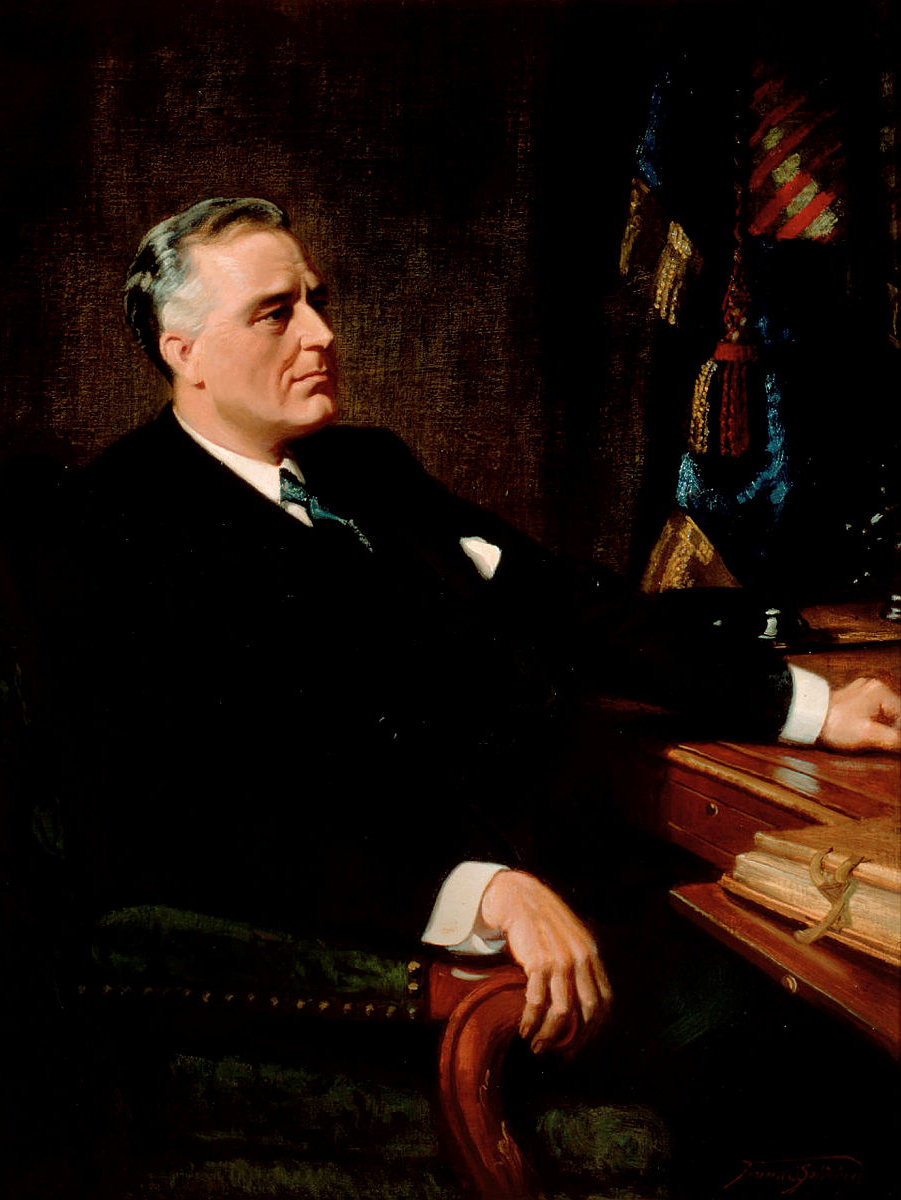
A Change in the Lineup?
On May 14, 1964, The Daily Record ran a lengthy anonymous story headlined, “Seven Presidents Have Vacationed at Monmouth Resorts.” In this telling, there are still seven presidents, but it’s not about where they worshiped, or where they summered, but a much more reasonable claim of “vacationed,” which seems appropriate.
But poor old Benjamin Harrison has been left out, despite documentation that he did in fact vacation in Elberon, after leaving office. And in his place? Franklin Delano Roosevelt.
On September 1, 1932, FDR gave speech in Sea Girt while running for president. Crowds estimated to be 125-300,000 people came to hear the future president’s address, or to view him as his caravan traveled through Monmouth County to Freehold. There is, however no evidence that has yet been found to suggest that FDR ever spent any vacation time here, or attended worship services here.
Including Grover Cleveland, whose inclusion is questionable and owed to a single source, the various claims in Monmouth County regarding presidents over this time include no less than twelve different chief executives: Grant, Hayes, Garfield, Arthur, Cleveland, Harrison, McKinley, Taft, Theodore Roosevelt, Wilson, Franklin D. Roosevelt, and Nixon.
A National Historic Landmark
On February 24, 1976, the St. James Chapel – now deconsecrated, sold, and rebranded as the “Church of the Presidents Museum” – applied for National Historic Landmark (NHL) status from the U.S. Department of the Interior.
The application has about fifteen paragraphs of detail about the Chapel in its “Statement of Significance.” These cover the history of the structure, its architectural features and qualities, and the special role of the Chapel within the Elberon community. Only one paragraph makes a claim about presidents:
Church of the Presidents got its name because at least six presidents of the United States worshipped here: Ulysses Grant, James A. Garfield, Chester A. Arthur, Woodrow Wilson, William McKinley and Rutherford B. Hayes. There are six bronze plaques on the walls in memory of each.
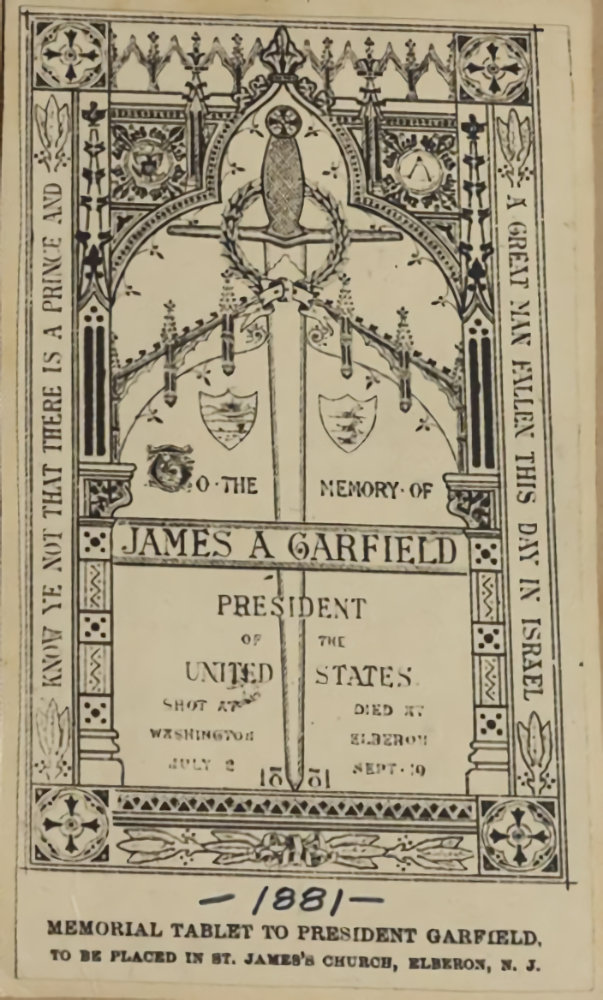
When the Museum received its NHL status, a historical marker was erected on the site, which still stands, and which bumped the claim up to seven presidents, with the addition of Harrison.
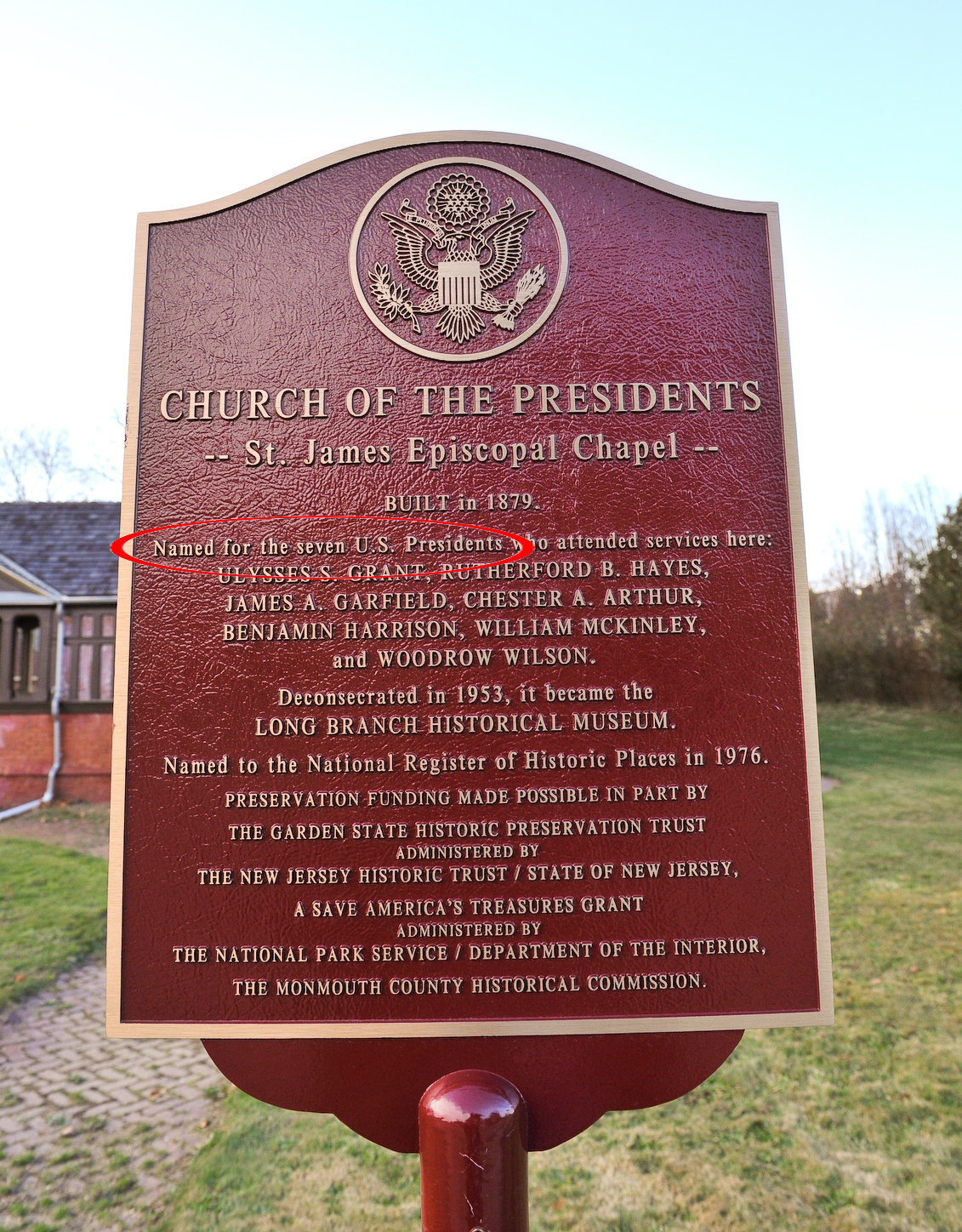
The sign currently marking the Church of the Presidents Museum. Image credit: John R. Barrows
The sign’s claim was explained in the application for historical preservation:
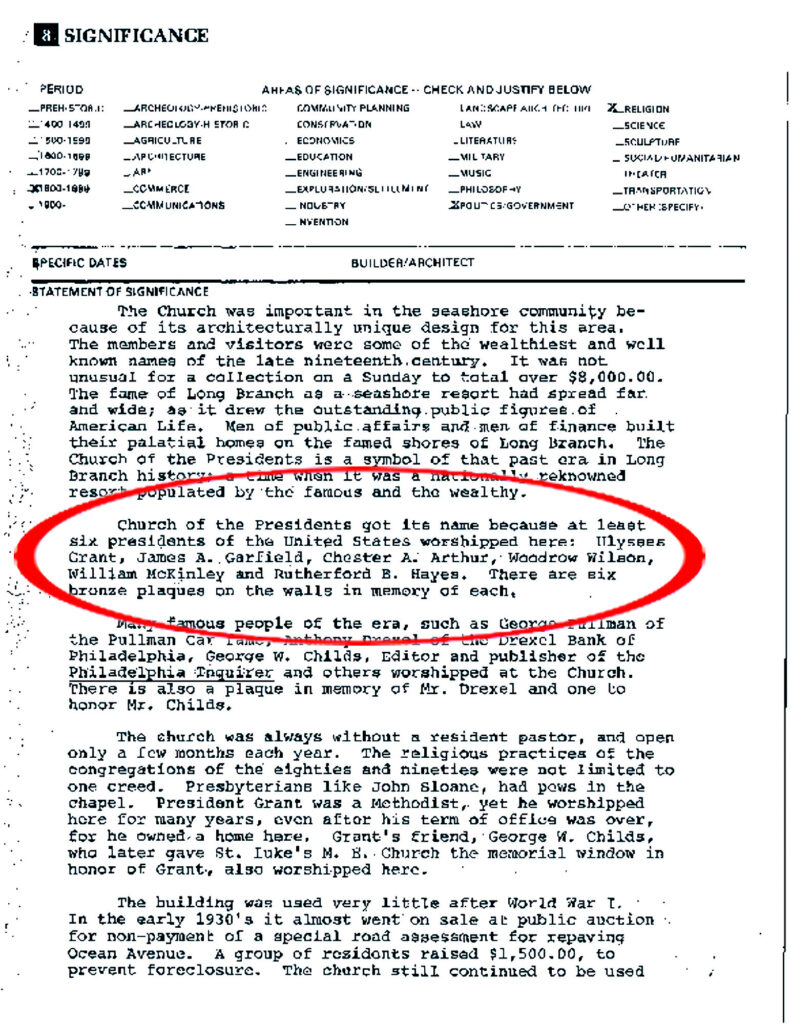
The Seven Presidents of Ocean Grove
Ocean Grove is an unincorporated community and census-designated place located within Neptune Township, about seven miles south of Long Branch. Ocean Grove has a long and rich history of its own, as well as its own National Historic Landmark, the “Great Auditorium.” In 1975, Ocean Grove was designated a State and National Historic District as a 19th-century planned urban community. It is said to have the most extensive collection of Victorian and early-20th century architecture in the United States.
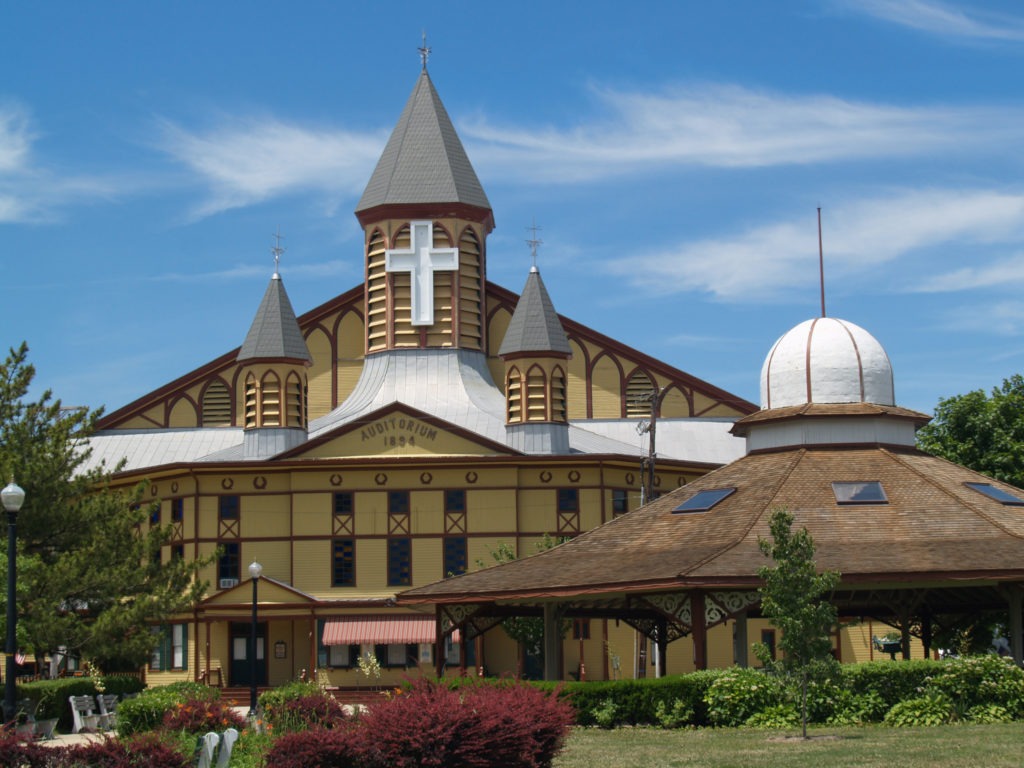
Over the years, Ocean Grove boosters have set forth their own seven presidents claim, but it was a long time in the making.
As noted previously, Ulysses S. Grant visited his sister in Ocean Grove while he summered in Long Branch, and Grant and his wife participated in Association anniversary ceremonies there. Garfield spent a summer at Ocean Grove before he was president, probably when he was a member of Congress from Ohio. McKinley, Taft, and Theodore Roosevelt all made prominent speeches at the Great Auditorium while serving as president. Woodrow Wilson visited Ocean Grove while governor of New Jersey, before he was president, but not while president.
That makes six. Wilson’s last visit took place on July 4, 1911. Ocean Grove would have six presidents to its credit for the next six decades, until October 16, 1970, when Richard Nixon – a Californian, and a Quaker by denomination – came to Ocean Grove and spoke at the Great Auditorium.
And finally they were able to claim seven presidents, with support for each claim, from Ocean Grove Association meeting minutes and other documents that are archived within the Historical Society of Ocean Grove Museum.
A Jewel in the Monmouth County Parks System
In 1976, Monmouth County and the city of Long Branch received approval from the State EPA for a 35-acre county-run oceanfront park to be called Seven Presidents Oceanfront Park that opened in 1977.
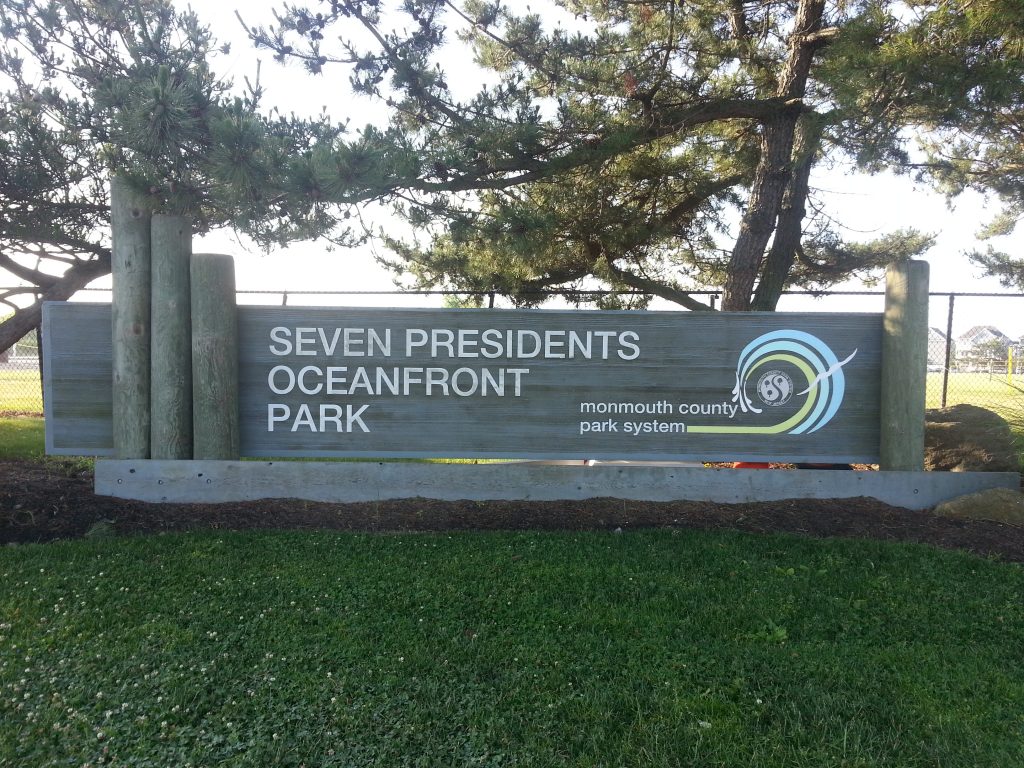
The park claims that seven presidents made Long Branch their summer residence:
Long Branch was placed “on the map” in 1869 when President Grant made the city the nation’s “Summer Capital,” a tradition followed by Presidents Hayes, Garfield, Arthur, Harrison, McKinley, and Wilson.
According to Gail L. Hunton, Chief Acquisition & Design Dept., Monmouth County Park System:
Long Branch’s association with seven US presidents who summered and/or visited there is documented in the secondary historical literature, various presidential biographies and articles that appeared in the popular periodicals of the day. For example, Entertaining a Nation, a WPA project published in 1940 and now digitally available online, provides considerable detail on presidential visits and summer residence.
The Church Calls Bravo Sierra on the Chapel
In 1931, Chaplain Winter planned another commemorative service at the Ocean Avenue chapel for Garfield. On September 4, Rev. Morton A. Barnes, pastor of the St. James Episcopal Church on Broadway in Long Branch, wrote a letter to the Asbury Park Press, stating that the Broadway edifice, and its predecessor structure, were the actual places where Garfield and Wilson attended services, and not the Ocean Avenue chapel.
Since there is serious doubt in the minds of those who have an intimate knowledge of the history of the chapel at Elberon, as to whether any president has worshipped in the building, it would seem as if the facts ought to be very thoroly [sic] established before the claim is made and especially in sending out appeals for financial aid under a title which might seem to be without foundation.
But that never happened, and, perhaps as a result, to this day unsubstantiated claims are still being made by the Church of the Presidents Museum; the town of Long Branch, via the Garfield Memorial Monument; and Monmouth County, via Seven Presidents Oceanfront Park. The worst exaggeration is the Parks System claim of seven presidents making Long Branch their summer home. This is absolutely false. In fact, out of all twelve presidents involved in one claim or another, only Ulysses S. Grant and Woodrow Wilson spent entire summers in Long Branch while in office. Garfield spent some vacation time here while as president. Four gave speeches at the Great Auditorium while in office. Some claims are for visits occurred before presidential election, others for visits after serving as chief executive.
But there is significant evidence to support many claims that Long Branch in particular was a destination known to presidents, and visited by presidents.
As for the Church of the Presidents, there is documentation – a single New York newspaper story – that Ulysses S. Grant attended services there, as former president. Similar scant documentation exists to support the claim that Harrison likewise worshiped there, as former president. Garfield and Wilson visited the main branch of the St. James Church but not the Chapel. McKinley was only here for about 36 hours and not on the Sabbath. Hayes and Arthur were figments of Bernard Sandler’s imagination; Hayes quite simply was never here, period, and Arthur’s visit took place while he was just Port Collector for New York.
If occasional civic exuberance over the years led to some exaggerated claims, in service to preserving a historic landmark, commemorating an assassinated chief executive, or in other regards, this is hardly unique to our region and does not change the fact that the Monmouth County shore towns, including Long Branch and Ocean Grove, were popular destinations for important people of all types, including American Presidents, and the region has much to be proud of in this regard.
Sources:
The National Anniversary. (1875). Ocean Grove Record, Ocean Grove, N.J., July 10, 1875, P. 2.
Latest News by Mail. (1879). Intelligencer Journal, Lancaster, Pa., June 10, 1879, P. 2.
Bishop Scarborough. (1879). The Daily Record, Long Branch, N.J., August 21, 1879, P. 1.
News Items. (1879). The Item, Passaic, N.J., Saturday, July 26, 1879, P. 2.
President Garfield and Cabinet at Long Branch. (1881). Lawrence Daily Journal, Lawrence, Ks., June 23, 1881, P. 1.
First Express Train. (1881). Ocean Grove Record, Ocean Grove, N.J., July 25, 1881.
The President’s Uncle Killed. (1881). The New York Times, New York, N.Y., June 23, 1881, P. 1.
Hedges, Charles. (1892). Speeches of Benjamin Harrison, Twenty-Third President of the United States. Complete collection of public addresses from February 1888 to 1892. United States Book Company, New York, N.Y.
Asbury Park’s Guests. (1889). Asbury Park Press, Asbury Park, N.J., July 4, 1889, P. 1.
Washington Topics. (1889). The Philadelphia Times, Philadelphia, Pa., May 12, 1889, P. 3.
Peace First Says McKinley. (1899). Asbury Park Press, Asbury Park, N.J., August 26, 1899, P. 1.
Picked Up by the Way. (1910). Monmouth Democrat, Freehold, N.J., March 17, 1910, P. 1.
President at Ocean Grove. (1911). Monmouth Democrat, Freehold, N.J., August 17, 1911, P. 1.
Garfield Monument Bill is Reported. (1911). The Daily Record, Long Branch, N.J., August 5, 1911, P. 1.
Japanese War Hero Likely to Review Children’s Parade. (1911). The Daily Record, Long Branch, N.J., August 5, 1911, P. 1.
Loyalty. (1914). Advertisement, Asbury Park Press, Asbury Park, N.J., May 1, 1914, P. 17.
Things Seen and Heard. (1919). The Daily Record, Long Branch, N.J., July 9, 1919, P. 8.
Harding is First Baptist President. (1921). The Daily Record, Long Branch, N.J., March 4, 1921, P. 7.
Hayes, Rutherford Birchard, and Williams, Charles Richard. ed. (1922). Diary and letters of Rutherford Birchard Hayes: Nineteenth President of the United States, Volume 1. Ohio State Archaeological and Historical Society, F.J. Heer Printing Company, Columbus, Ohio.
$150,000 West End Casino Planned. (1924). Asbury Park Press, Asbury Park, N.J., October 6, 1924, P. 2.
Memorial Services Held in Elberon Church. (1925). The Daily Record, Long Branch, N.J., July 30, 1925, P. 4.
Debt of $650 Menaces “Church of the Presidents.” (1925). Asbury Park Press, Asbury Park, N.J., August 7, 1925, P. 1.
To Have Memorial Services at Elberon. (1925). The Daily Record, Long Branch, N.J., August 8 1925, P. 1.
Historic Chapel, Attended by Six Presidents, Saved from Sale to Pay Tax Assessments. (1925). The New York Times, New York, N.Y., August 24, 1925, Page 1.
“Church of the Presidents” is Centre of Interest. (1925)., The Daily Record, Long Branch, N.J., August 29, 1925, P. 1.
“The Church of the Presidents.” (1925). The Daily Record, Long Branch, N.J., August 12, 1925, P. 6.
Garfield Memorial Service to be Held. (1925). The Daily Record, Long Branch, N.J., August 15, 1925, P. 1.
Will Have President Grant Service Sunday. (1925). The Daily Record, Long Branch, N.J., August 7, 1925, P. 14.
Mallon, Paul R. (1925). Bryan to Rest in Warrior’s Grave Beside Unknown Soldier; Last Rites, Simple Ceremony. United Press, published in The Courier News, Plainfield, N.J., July 31, 1925, P. 1.
Bryan Funeral Today; Nation Pays Tribute. (1925). Asbury Park Press, Asbury Park, N.J., July 31, 1925, P. 1.
Things Seen and Heard. (1927). The Daily Record, Long Branch, N.J., September 16, 1927, P. 6.
Washington Church to Honor Lincoln. (1929) The Daily Record, Long Branch, N.J., July 25, 1929, P. 14.
Monmouth Beach Inn Razed by Fire; Loss Placed at $150,000. (1929). The Daily Record, Long Branch, N.J., December 27, 1929, P. 1, 12.
Church of the Presidents Marks 52nd Anniversary. (1930). Asbury Park Press, Asbury Park, N.J., June 17, 1930, P. 17.
Church of the Presidents. (1930). Asbury Park Press, Asbury Park, N.J., June 21, P. 12.
Begins Move to Organize Parish. (1930). The Daily Record, Long Branch, N.J., June 28, 1930, P. 1.
Huge Crowd Greets Governor Roosevelt. (1932). Monmouth Democrat, Freehold, N.J., September 1, 1932, P. 1.
Church Seeks Shrine Status. (1947). Asbury Park Press, Asbury Park, N.J., July 29, 1947, P. 1.
Seven Presidents Have Vacationed at Monmouth County’s Resorts. (1951). The Daily Record, Long Branch, N.J., July 31, 1951, P. 39.
Broker Sells Sand and Surf Hotel, West End Casino, Colony Surf Club. (1953). The Daily Record, Long Branch, N.J., January 1, 1953, P. 1.
Seven Presidents Visited Resorts at Jersey Shore. (1954). Asbury Park Press, Asbury Park, N.J., November 17, 1954, P. 101.
Opie, E. Walton, & Smith, H. Alexander. (1958). Final Report of the Woodrow Wilson Centennial Commission, U.S. Government Printing Office, Washington, D.C., P. 194. Available: https://books.google.com/books?id=7Zw6AQAAIAAJ&pg=PR1#v=onepage&q=long%20branch&f=false
West End Casino to Become Racquet Club. (1967). The Daily Record, Long Branch, N.J., March 13, P. 5
County-run City Park Approved. (1976). The Daily Record, Long Branch, N.J., November 26, 1976, P. 9.
Nomination Form, National Record of Historic Places Inventory. (1976). United States Department of the Interior, National Park Service, Feb 24, 1976. Available: https://npgallery.nps.gov/NRHP/GetAsset/NRHP/76001169_text.
Garfield’s Again Standing Up on His Own 2 Feet. (1978). Asbury Park Press, Asbury Park, N.J., July 30, 1978, P. 44.
Brown, Harry James, & Williams, Frederick D., eds. (1981). The Diary of James A. Garfield. Michigan State University Press, East Lansing, Mich., 1967-1981, Vols. 1-4.
Dinkelspiel, Edgar N. (1989). Long Branch is Losing Too Much of its History. Asbury Park Press, Asbury Park, N.J., April 1, 1989, P. 9.
Williams, Carol Gorga. (1989). Many Presidents Stopped at Shore. Asbury Park Press, Asbury Park, N.J., July 11, 1989, P. C12.
Greer, Juliet. (2000). Ocean Grove Church Service Draws 5,000. Asbury Park Press, Asbury Park, N.J., August 7, 2000, P. 9.
Chesler, Caren. (2010). A Seaside Gem Sparkles Again. New Jersey Monthly, Morristown, N.J., May 7, 2010.
Benjamin Harrison’s Summer White House: Congress Hall. (2015). Livejournal, July 15, 2015. Available: https://potus-geeks.livejournal.com/616853.html
Walker, Tamara. (2015). Hey, Who Knew? Quick History of Ocean Grove, God’s Square Mile. The Asbury Park Press, Asbury Park, N.J., October 28, 2015, P. 13A.
Lucretia’s Holiday Gone Wrong. (2020). James A Garfield National Historic Site, Mentor, Ohio, National Park Service, U.S. Department of Interior, July 22, 2020. Available: https://www.nps.gov/articles/000/lucretia-s-holiday-gone-wrong.htm
Speeches & Messages of Rutherford B. Hayes. (2022). The Rutherford B. Hayes Presidential Library & Museums, Spiegel Grove, Ohio. Available: https://www.rbhayes.org/.
History of the Site: Seven Presidents Oceanfront Park. (2022). Monmouth County Parks System. Available: https://www.monmouthcountyparks.com/page.aspx?Id=2535.
Online Collections of Presidential Papers. (2022). American University, Washington, D.C. Available: https://subjectguides.library.american.edu/prespapers.
Zablocki, Peter. (2022). Presidential Visits to New Jersey: A History. The History Press, Columbia, S.C.
Thompson, Earle. (? ). St. James Episcopal Church: Our Parish History. Unpublished manuscript. Reprint courtesy Long Branch Free Public Library, History Room, Long Branch, N.J.
Image: Monmouth House, Spring Lake Beach, New Jersey. Rear view. (1878). Woolman & Rose, Philadelphia, Pa. David Rumsey Historical Map Collection. Available: https://www.davidrumsey.com/luna/servlet/detail/RUMSEY~8~1~23033~800096:Monmouth-House,-Spring-Lake-Beach,-
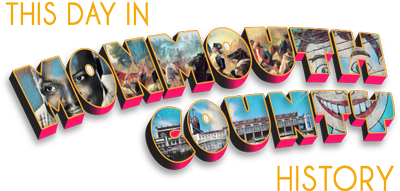
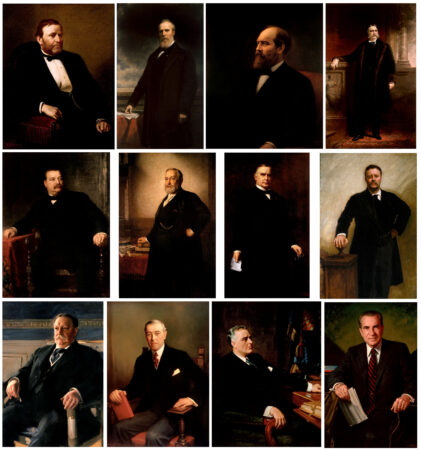
Leave a Reply